|
Before
the whining drowns it out,
Listen
to the New India - By Arun Shourie
Arun
Shourie, India's Union Minister for Disinvestment,
Communications & Information Technology, tells us why we
need to listen to the New India.
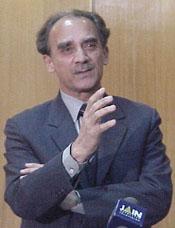 Twenty
to twenty-five years ago, even 10 years ago, few of us had heard
of Information Technology. Today, exports from this industry are
worth $10 billion — that is, over Rs 45,000 crore a year. That
figure is 20 per cent of our total exports. Twenty
to twenty-five years ago, even 10 years ago, few of us had heard
of Information Technology. Today, exports from this industry are
worth $10 billion — that is, over Rs 45,000 crore a year. That
figure is 20 per cent of our total exports.
In spite of
the fact that each of the markets to which we supply IT software
and solutions has been in the trough of recession for years, IT
exports have grown by 26 per cent this year.
Infosys
had not even been born 25 years ago. Wipro was a company selling
vegetable oil. Indeed, other than the ‘‘Tata’’ in Tata
Consultancy Services, there is scarcely a name in the IT
industry that was known then.
And guess what the average age is in the industry? Just 26 and a
half! These 26/27-year-olds have changed the world’s
perception of India.
It’s not just a country of
snake-charmers, it’s a country against which protectionist
walls have to be erected. Of course, we can also charm snakes. And these 26-year-olds are changing India’s perception also of
itself: that India can; that, therefore, we should face the
world with confidence.
At a
moment’s notice, my friends Amit Mitra of FICCI and Tarun Das
of CII send me particulars of firm after firm, in sector after
sector, that has broken new ground. A sample:
•
Fifteen of the world’s major automobile manufacturers are now
obtaining components from Indian firms.
• Just last year, exports of auto-components were $375
million. This year they are close to $1.5 billion. Estimates
indicate they will reach $15 billion within six to seven
years.
• Hero Honda is now the largest manufacturer of motorcycles in
the world—with an output of 17 lakh motorcycles a year.
• One lakh Indica cars of the Tatas are to be marketed in
Europe by Rover, one of the United Kingdom’s most prestigious
auto-manufacturers under its — that is, Rover’s — brand
name.
• Bharat Forge has the world’s largest single-location
forging facility — of 1.2 lakh tonnes per annum. Its client
list includes Toyota, Honda, Volvo, Cummins, Daimler Chrysler.
It has been chosen as a supplier of small forging parts for
Toyota’s global transmission parts’ sourcing hub in
Bangalore.
• Asian Paints has production facilities in 22 countries
spread across five continents. It has recently acquired Berger
International, which gives it access to 11 countries, and SCIB
Chemical SAE in Egypt. Asian Paints is the market leader in 11
of the 22 countries in which it is present, including
India.
• Hindustan Inks has the world’s largest single stream,
fully integrated ink plant, of 1 lakh tonnes per annum capacity,
at Vapi, Gujarat. It has a manufacturing plant and a 100 per
cent subsidiary in the US. It has another 100 per cent
subsidiary in Austria.
• For two years running, General Motors has awarded Sundaram
Clayton its ‘Best Supplier Award’; the volumes it sources
out of India are growing every year.
• Ford has presented the ‘Gold World Excellence Award’ to
Cooper Tyres.
• Essel Propack is the world’s largest laminated tube
manufacturer. It has a manufacturing presence in 11 countries
including China, a global manufacturing share of 25 per cent,
and caters to all of P&G’s laminated tube requirements in
the US, and 40 per cent of Unilever’s.
• Aston Martin, one of the world’s most expensive car
brands, has contracted prototyping its latest luxury sports car
to an India-based designer. This would be the cheapest car to
roll out of Aston Martin’s stable.
• Maruti has been the preferred supplier of small cars under
the Suzuki brand for Europe. Suzuki has now decided to make
India its manufacturing, export and research hub outside
Japan.
• Hyundai Motors India is about to become the parent Hyundai
Motors Corporation’s global small car hub. In 2003, HMC will
source 25,000 Santros from HMI’s plant in India. By 2010 HMI
is targeted to supply half a million cars to HMC. It was only in
1999 that HMI got its first outsourcing contract and already, in
2003, 20 per cent of its sales will be what it supplies as an
outsourcing hub. It is exporting cars to Indonesia, Algeria,
Morocco, Columbia, Nepal, Sri Lanka and Bangladesh.
• Ford India got its first outsourcing contract in 2000.
Within 3 years outsourcing accounts for 35 per cent of its
sales. Ford India supplies to Mexico, Brazil and China. The
parent Ford is sourcing close to $40 million worth of components
from India, and plans to increase these in the coming
years.
Ford India is already the sole manufacturing and supply base for
Ikon cars and components. These are being exported to Mexico,
China and Africa.
• Toyota Kirloskar Motors chose India over competitive
destinations like Philippines and China for setting up a new
project to source transmissions as this option proved more
economical.
• Europe’s leading tractor maker, Renault, has chosen
International Tractors (ITL) as its sole global sourcing hub for
40 to 85 horsepower tractors.
• Tyco Electronics India bagged its first outsourcing contract
in 1998-99. So successful has it been that components and
products others have contracted from it already account for 50
per cent of its total sales. It supplies to the parent, Tyco
Europe.
• TISCO is today the lowest cost producer of hot-rolled steel
in the world.
• TVS Motor Company has been awarded the coveted Deming Prize
for Total Quality Management. Many of the largest of
organisations, even American ones—like GE—have not managed
that recognition yet!
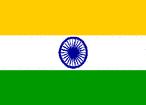 India’s
pharmaceutical industry has come to be feared as much as its
infotech industry. It is already worth $ 6.5 billion and it has
been growing at 8-10 per cent a year. It’s the fourth largest
pharmaceutical industry in terms of volumes and 13th in value.
Its exports have crossed $2 billion, and have increased by 30
per cent in the past five years. India is among the top five
manufacturers of bulk drugs. Even more telling is another
figure. We are always being frightened, ‘‘Multinational drug
companies are about to takeover.’’ In 1971 the share of
these MNCs in the Indian market was 75 per cent. Today it’s 35
per cent!
India’s
pharmaceutical industry has come to be feared as much as its
infotech industry. It is already worth $ 6.5 billion and it has
been growing at 8-10 per cent a year. It’s the fourth largest
pharmaceutical industry in terms of volumes and 13th in value.
Its exports have crossed $2 billion, and have increased by 30
per cent in the past five years. India is among the top five
manufacturers of bulk drugs. Even more telling is another
figure. We are always being frightened, ‘‘Multinational drug
companies are about to takeover.’’ In 1971 the share of
these MNCs in the Indian market was 75 per cent. Today it’s 35
per cent!
There’s
another feature we should bear in mind: India’s strengths are
becoming evident across the technology spectrum:
• We
are among the three countries in the world that have built supercomputers
on their own, the US and Japan being the other two: two months
ago, the fourth generation PARAM
super-computer was inaugurated in Bangalore.
• We are among six countries in the world that launch
satellites. We launch some of our own satellites of
course; we have launched satellites for others too, among them
such countries as Germany and Belgium. We have the largest set
of remote sensing satellites. Our INSAT
system is also among the world’s largest domestic satellite
communication systems.
At the other
end:
• India
is one of the world’s largest diamond cutting and polishing
centres. CLSA estimates nine of every 10 stones sold in the
world pass through India.
• Trade of Indian medicinal plants has crossed Rs 4,000 crore.
Our foreign
exchange reserves are at an all-time high—$82 billion. We have
announced that we will not be taking aid from a string of
countries.
•
We are giving aid to 10 or 11 countries.
• We are pre-paying our
debt.
• We have just
‘‘loaned’’ $300 million to the IMF!
How distant
the days when we used to wait anxiously for the announcement
about what the Aid India Club meeting in Paris had decided to
give us.
(source: Before
the whining drowns it out, listen to the new India - By Arun
Shourie and When
sky is the limit - By Arun Shourie - indian-express.com
August 15, 16 and 17).
In
a 3-part provocative series, India's Union Minister for
Disinvestment, Communications & Information Technology,
tells us why we need to listen and act. For more on Arun Shourie
refer to The
Arun Shourie Site.
Top
of Page
Hindu Temple
lays beneath the Ayodhya structure
In
what could be a turning point in the Ayodhya dispute, the
Archaeological Survey of India (ASI) has reported to the High
Court here that its excavations found distinctive features of a
10th century temple beneath the Babri mosque site even as the
Sunni Central WAQF Board termed the report as "vague and
self-contradictory".
The
report said there was archaeological evidence of a massive
structure just below the disputed structure and evidence of
continuity in structural activities from the 10th century
onwards upto the construction of the disputed structure (Babri
mosque).
Among
the excavation yields it mentioned were stone and decorated
bricks as well as mutilated sculpture of divine couple and
carved architectural members including, foliage patterns,
Amalaka, Kapotapali, Doorjamb with semi-circular shrine
pilaster, broke octagonal shaft of black schist pillar, lotus
motif, circular shrine having pranjala (watershute) in the north
and 50 pillar bases in association with a huge structure.
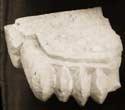

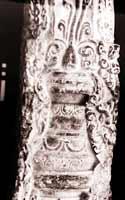

Among
the excavation yields it mentioned were stone and decorated
bricks as well as mutilated sculpture of divine couple and
carved architectural members.
For more images refer to chapter
on GlimpsesVIII).
Watch
History
of Ayodhya - videogoogle.com.
The
archaeological evidence and other discoveries from the site were
indicative of remains which are distinctive features found
associated with the temples of north
India, the ASI report said.
The
ASI report said there is sufficient proof of existence of a
massive and monumental structure having a minimum dimension of
50x30 metres in north-south and east-west directions
respectively just below the disputed structure.
In
course of present excavations nearly 50
pillar bases with brick bat foundation below calcrete
blocks topped by sandstone blocks were found, the report said.
(source:
Hindu
Temple lays beneath - dailypioneer.com -
August 26 2003).
***
Rampant
Negationism : The Indian Marxists - By Koenraad Elst
One should know that there is a strange alliance between the
Indian communist parties and the Muslim fanatics. Marxism
dehumanizes people to impersonal pawns, or “forces” in the
hands of god History. The Marxist
historians had the field all to themselves, and they set to work
to “decommunalize” Indian history-writing, ie. To erase the
importance of Islam as a factor of conflict.
In Communalism and the Writing of
Indian History, Romila Thapar, Harbans Mukhia and
Bipin Chandra, professors at Jawaharlal Nehru University
(JNU, the Mecca of “secularism” and negationism) in Delhi,
write that the interpretation of medieval wars as religious
conflicts is in fact a back-projection of contemporary religious
conflict artificially created for political purposes. They
explicitly deny that before the modern period there existed such
a thing as Hindu identity or Muslim identity. Conflicts could
not have been between Hindus and Muslims, only between rulers or
classes who incidentally also belonged to one religious
community or the other. It is of course a fact that in the
Jewish ghetto in Warsaw the Nazis employed Jewish guards: this
does not disapprove Nazi-Jewish enemity. Time
and again, the negationist historians (including Bipan Chandra,
K N Panikkar, S. Gopal, Romila Thapar, Harnans Mukhia, Irfan
Habib, R S Sharma, Gyandra Pandey, Sushil Srivastava, Asghar Ali
Engineer, as well as the Muslim fundamentalist politician Syed
Shahabuddin) have asserted that the tradition according to which
the Babri mosque forcibly replaced a Hindu temple, is nothing
but a myth purposely created in the 19th century.
To explain the popularity of the myth even among local Muslim
writers in the 19th century, most of them say it was
a deliberate British concoction, spread in the interest of the
“divide and rule” policy. They affirm this conspiracy
scenario without anyhow citing, from
the copious archives which the British administration in India
has left behind, any kind of positive indication for
their convenient hypothesis – let alone the rigorous proof on
which a serious historian would base his assertions, especially
in such controversial questions.
Personal Attacks on Opponents
In December 1990, the leading JNU historians and several
allied scholars, followed by the herd
of secularist pen-pushers in the Indian press, have
tried to raise suspicions against the professional honesty of
Prof. B B Lal and Dr. S P Gupta, the archaeologists who have
unearthed evidence for the existence of a Hindu temple at the
Babri Masjid site. Rebuttals by these
two and a number of other archaeologists have received minimal
coverage in the secularist press.
I have been thinking of the behavior of our Marxist friends
and historians, their unprovoked slander campaign against many
collegues, hurling abuses and convicting anyone and everyone
even before the charges could be framed and proved. Their latest
target is so sober and highly respected a person as Prof. B B
Lal, who has all his life never involved himself in petty
politics or in the groupism so favorite a sport among the
so-called Marxist intellectuals of this country. But
then slander is a well-practised art among the Marxists.”
(source:
Negationism
in India - By Koenraad Elst p.
37 -41). Refer
to My
People, Uprooted: "A
Saga of the Hindus of Eastern Bengal"
- By Tathagata Roy.
Watch History
of Ayodhya - videogoogle.com.
***
Grave
allegation to lob against a reputed body
Marxist
historian Irfan Habib trashed the Archaeological
Survey of India’s (ASI’s) report submitted to the Allahabad
High Court at a press conference organised by the Safdar Hashmi
Memorial Trust on Friday. He said the ASI’s excavations
actually proved the Babri Masjid was built on the ruins of a
mosque. But
he couldn’t explain why a mosque would have been razed to
build a new one.
***
But
the likes of Habib and Suraj Bhan don’t seem to have the patience to
wait. They have sought to disparage the
ASI’s competence.
 Actually,
the hostility goes back to the very
beginning of the ASI exercise. When the Allahabad High Court
ordered the excavation, Habib and Bhan insisted there was no
need to do so. In their opinion, nothing lay beneath the former
site of the Babri Masjid. They also questioned the competence of
Tojo Vikas, which had reported anomalies beneath the surface
after an imaging survey. After the excavation, Habib
and Bhan objected to horizontal digging as it would destroy the
flooring of the mosque, pretending this had historical value.
They ignored that in the event of reconstruction of the mosque,
the flooring would in any case have to removed. Actually,
the hostility goes back to the very
beginning of the ASI exercise. When the Allahabad High Court
ordered the excavation, Habib and Bhan insisted there was no
need to do so. In their opinion, nothing lay beneath the former
site of the Babri Masjid. They also questioned the competence of
Tojo Vikas, which had reported anomalies beneath the surface
after an imaging survey. After the excavation, Habib
and Bhan objected to horizontal digging as it would destroy the
flooring of the mosque, pretending this had historical value.
They ignored that in the event of reconstruction of the mosque,
the flooring would in any case have to removed.
Later,
when unannotated interim reports from the ASI were submitted to
the court, Habib and his friends started interpreting them to
mean no temple structure existed beneath the mosque. When one of
the interim reports suggested an anterior structure beneath the
mosque, they concluded it was an earlier mosque, constructed
during the Sultanate period. They
ignored that there was no corroborative evidence of a mosque
preceding the Babri Masjid. No such Sultanate mosque was ever
mentioned in contemporary writings. Glazed
ware has been found used as early as the Kushan period. Lime and
mortar were used in the Sanchi stupa, second century BC, as well
as in the Gupta period. Such material was also used in Sarnath
in the 11th and 12th centuries.
Eminent
scholars as they are, Habib and Bhan
ought to know antiquity of a structure is determined not by
tiles, lime and mortar but by carbon dating of organic
substances. This was reportedly undertaken by the ASI.
If
animal bones found by the ASI date the structure to at least the
10th C, it can be safely concluded the structure was
pre-Islamic. Animal sacrifice was common enough in Hindu
temples. That apart, it is not
understood how Habib and Bhan ignored numerous terracotta
figurines and divine sculptures, suggestive of Hindu origin.
Their silence in this regard is baffling. It
would appear that the two scholars have a political agenda, of
prejudicing public opinion against the ASI report even before
judicial scrutiny. Should the court ratify the ASI report,
Indian Muslims have no reason to be apologetic for what Babar,
an invading outsider, may have done 500 years ago.
(source:
Temple
and the truth - By Bulbul Roy Mishra - indianexpress.com).
Considering
that only 15 per cent of all the archaeological excavations
undertaken in India since Independence are properly published,
the submission of a full report on any excavated site in the
country should be a matter of great rejoicing among
archaeologists.
To
cast a slur on the findings of what is undoubtedly the best and
most dependable professional archaeological organisation in the
country is an act of pure political expediency. Whatever we can
accuse the ASI of, conscious falsification of data cannot be one
of them.
(source:
It’s
the archaeology, stupid! - by Dilip
K. Chakrabarti August
29 2003). For more on Eminent Marxists JNU historians refer to ICHR's
The Eminent Entrepreneurs!
- By Arun Shourie
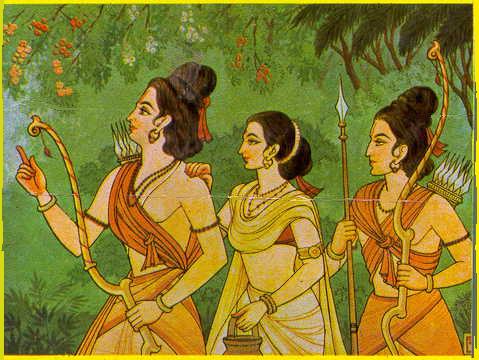
Lord
Ram, Sita and Laxshman.
Watch
History
of Ayodhya - videogoogle.com.
***
Slinging
mud at a respected national institution, one that has earned
international praise for its competence in the field- Angkor
Vat's conservation in Cambodia is only one of its celebrated
achievements. Charges of the report being "doctored"
are even more unbecoming when lobbed by 'secular' academics, on
the specious ground none of the interim reports had mentioned a
temple.
(source:
Ayodhya
- What lies ahead
- dailypioneer.com - Editorial August
27 2003
).
Nayanjot
Lahiri,
a leading archaeologist in the country, who has gone through the
ASI report, thinks that some of the points raised by Habib are
"themselves very questionable". Lahiri,
Reader in Delhi University's history department, finds the
charge baseless and points out that it was the Allahabad High
Court which had ordered the ASI to excavate the site to attest
the anomalies mentioned in an earlier ground penetrating radar (GPR)
survey report. "The ASI was simply covering the area the
GPR survey had covered," she said.
Lahiri's
most serious charge against the ASI's critics
is
that they are
"communalising
artefacts along religious lines".
 Koenraad
Elst (1959 -) Dutch historian,
born in Leuven, Belgium, on 7 August 1959, into a Flemish (i.e.
Dutch-speaking Belgian) Catholic family. He graduated in
Philosophy, Chinese Studies and Indo-Iranian Studies at the
Catholic University of Leuven. During a stay at the Benares
Hindu University, he discovered India’s communal problem and
wrote his first book about the budding Ayodhya conflict - Ayodhya
and After: Issues Before Hindu Society. Koenraad
Elst (1959 -) Dutch historian,
born in Leuven, Belgium, on 7 August 1959, into a Flemish (i.e.
Dutch-speaking Belgian) Catholic family. He graduated in
Philosophy, Chinese Studies and Indo-Iranian Studies at the
Catholic University of Leuven. During a stay at the Benares
Hindu University, he discovered India’s communal problem and
wrote his first book about the budding Ayodhya conflict - Ayodhya
and After: Issues Before Hindu Society.
He
writes: "While the true fanatics led by Marxist
Historian Irfan Habib simply ignore the new evidence
as they have ignored the old, we see the slightly more cautious
secularists retreat to the next line of defence. They
use these fanatics as a counterbalance to the scientific
findings, which they in turn conflate with the "Hindu
chauvinists", to create a semblance of even-handedness with
themselves in the reasonable middle position between two
fanatical parties, one of these in effect including the ASI.
This way, they can still maintain that there is no conclusive
proof for the temple, as if Habib's dogmatic denials are equal
in value with the scientific findings of a team of top
archaeologists.
The BBC correspondent (and following
her, most of today's European newspapers) claims that the issue
remains unresolved. But if you read on, you find that
this only means that some of the long-standing evidence deniers
merely keep on denying the evidence. So yes, there are still two
positions: those who stand by the evidence and those who deny it
or explain it away with contrived and totally ridiculous stories.
But
no fair reporter would treat those two positions, science
and anti-science, as being of equal validity or equal
seriousness in any other controversy."
(source:
Hindu
Unity.com).
For
more on Koenraad Elst refer to chapter Quotes201_220).
Dr.
N S Rajaram
said the facts that emerged from the recent excavations were
already known during ASI's investigation 20 years back. "The
facts released decades back have been already used by me for my
book on the issue 'Profile
in Deception- Ayodhya and the Dead Sea Scrolls'
which was published in 2000. The new report reveals
nothing different. These facts have been known for decades,'' Dr
Rajaram said.
Dr
Rajaram has appealed to the people to accept the existence of
the 10th century old temple at the site. "It was already
known that the Ram Janmabhoomi temple was on the Ayodhya site.
Previous excavations have shown this. The government should
first accept this reality before it frames its policies on the
matter.''
(source:
Accept
temple existed at Ayodhya, says historian -
timesofindia.com).
Sir
V S Naipaul has supported the Ram Janmabhoomi
movement and the idea to build a temple at Ayodhya and expressed
his sympathy for Hindu Revivalism.
For more about Ayodhya refer
to V S Naipaul -
chapter on
Quotes251_270
and Islamic
Onslaught).
A
Civilisational failure among our elite
It
reveals a civilisational failure among
our elite, an unwillingness, or inability, to grapple with
fundamental issues of identity and ethos that are fast
crystallising in the nation as a whole. These issues
will not subside, not least because a religion-inspired
terrorism is undermining the very secular state that protects
its right to exist. None but the most obtuse can fail to see
that this contradiction must give way, sooner or later. Nothing
encapsulates the twin issues of national identity and
civilisational ethos like Ayodhya. The
ASI's unearthing evidence of an ancient Hindu temple is a
powerful vindication of the millions of Ram bhakts who kept
alive the memory of the God's birthplace through centuries of
displacement and disempowerment.
The
nation owes a deep debt of gratitude to Dr Hari Majhi, Dr BR
Mani and their colleagues, who submitted their professional
honour and credibility to constant hostile
scrutiny through five months of excavations, and
maintained a dignified silence in the face of patently false
media reports about the findings, which intended to intimidate
them from making a definitive statement about the nature of
their discoveries. Thus, there is credible evidence
that a temple/structure was demolished and a mosque built. Other
findings include stone and decorated bricks, a mutilated
sculpture of a divine couple, carved architectural members
including foliage patterns, amalaka, kapolapali, doorjamb with
semi-circular pilaster, broken octagonal shaft of black schist
pillar, lotus motif, circular shrine with a pranala
(water-chute) in the north, 50 pillar bases, all of which are
distinctive features of North Indian temples.
(source: A
civilisational failure among our elite - By Sandhya Jain -
dailypioneer.com - September 8, 2003).
Top
of Page
Secular
spoilers and Ayodhya - By MC
Joshi
Amongst
these, Hindu secular fundamentalists
are more loyal than the king. They have made it a
habit of blaming and interrogating only their own community.
They insist the dispute be seen only from 1992, not from 1526.
While they go thousands of years back to dig out cases of
oppression by Hindus, they
want Hindus to forget the history of 800 years of oppression at
the hands of Muslim invaders and rulers.
The
status of Ayodhya as the birthplace of Lord Ram and its sacred
association for Hindus are beyond question. Nobody can deny that
Babar's men built the disputed mosque in Ayodhya. In
spite of the historical background, many Hindus openly condemn
the demolition of the mosque. These 'secularists' do not even
accept that Ayodhya, Kashi and Mathura did not and do not bear
any legitimate significance for Muslims.
They
are only laid claims to as symbols of Hindu humiliation.
There was no other reason mosques were
built at the sites of three of the holiest Hindu shrines by
Muslim rulers.
There
have been other moderate Muslim voices that have used the
Western media to say no mosque exists in Ayodhya presently and
Muslims know that-even if a court verdict goes in their favour-no
power in the world could enable them to build a mosque at the
site. In contrast, while reacting to the suggestion that a
solution may emerge if Muslims take the lead in 'give-and-take'
by offering the disputed site to Hindus, a Hindu journalist has
said that breaking the impasse without a court verdict would
initiate similar demands in villages across the country.
Virtually questioning the existence of a Ram temple at the site,
he said even the most well-known Ram-bhakt, Tulsidas, made no
mention of it. It is such illogic that makes reconciliation
impossible. Tulsidas was neither a
journalist nor a historian. His literature dwelt on the lifetime
of Lord Ram, thousands of years before the birth of Islam.
There
can, of course, be an amicable settlement if Muslims do make a
grand gesture on Ayodhya and Hindu organisations respond by
abandoning all further attempts to right "historical
wrongs", as suggested by Mr Mitra. But
that does not seem to suit the 'secular' spoilers.
(source: Secular
spoilers and Ayodhya - By MC
Joshi July
28 2003).
Top
of Page
Hindu Kush -
Hindu Holocaust
Learning from
History - By Francois Gautier
Like the Jews, Hindus
too have suffered a terrible Holocaust, probably without
parallel in human history. Take
the Hindu Kush, for instance; probably, one of the biggest
genocides in the history of Hindus. There has
practically been no serious research on the subject or mention
in history books. The Hindu Kush is a mountain system nearly
1,000 miles long and 200 miles wide, running north-east to
south-west and dividing the Amu Darya valley and the Indus
valley. The Hindu Kush has over two dozen summits of more than
23,000 feet and historically its passes, particularly the
Khyber, have been of great military significance, for they
provide access to the northern plains of India. Most foreign
invaders have used the Khyber Pass: Alexander the Great in 327
BC, Mahmud of Ghazni, in 1001 AD; Timur Lane in 1398 AD; and,
Nadir Shah in 1739 AD.
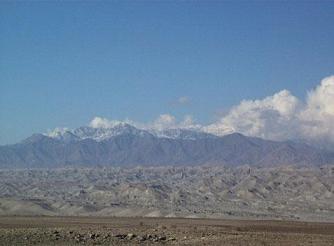

Hindu
Kush mountains and valley
Hindu
Kush: "The name means literally 'Kills the Hindu', a
reminder of the days when Hindu slaves from Indian subcontinent
died in harsh Afghan mountains while being transported to Moslem
courts of Central Asia."
Refer
to chapter on Islamic
Onslaught
***
Yet,
in the first millennium before Christ, two major Hindu kingdoms,
those of Gandhaar (Kandahar) and Vaahic Pradesh (Balkh of
Bactria) had their borders extending far beyond the Hindu Kush.
The kingdom of Gandhaar, for instance, was established by Taksha,
the grandson of Bharat of Ayodhya, and its borders went from
Takshashila (Taxila) to Tashkent (corruption of Taksha Khand) in
present day Uzbekistan. In the later period, the Mahabharat
speaks of Gandhaari as a princess of Gandhaar and her brother,
Shakuni, as a prince and later as Gandhaar's ruler (the last
Hindu Shahiya king of Kabul, Bhimapal, was killed in 1026 AD).
Then
came, in 3rd century BC, Buddhist emperor Kanishka, whose empire
stretched from Mathura to the Aral Sea (beyond the present day
Uzbekistan, Tajikistan, and Krygzystan) and under his influence
Buddhism flourished in Gandhaar. The two giant Buddha sandstones
carved into the cliffs of Bamian, which were destroyed by the
Taliban, date from the Kanishka period. In Persian, the word 'Kush'
is derived from the verb 'Kushtar' - to slaughter or carnage. Encyclopaedia
Americana says of Hindu Kush:
"The name means literally 'Kills the Hindu', a reminder of
the days when Hindu slaves from Indian subcontinent died in
harsh Afghan mountains while being transported to Moslem courts
of Central Asia."
Encyclopaedia
Britannica on its part mentions "that the name
Hindu Kush first appears in 1333 AD in the writings of Ibn
Battutah, the medieval Berber traveller, who said the name meant
'Hindu Killer', a meaning still given by Afghan mountain
dwellers". Unlike the Jewish holocaust, the exact toll of
the Hindu genocide suggested by the name Hindu Kush is not
available. "However, writes Hindu Kush specialist Srinandan
Vyas, "the number is easily likely to be in millions."
, "1,500,000 residents perished". "Thus,"
writes Vyas, "it is evident that the mountain range was
named as Hindu Kush as a reminder to the future Hindu
generations of the slaughter and slavery of Hindus during the
Muslim conquests."
Why
does not the Government of India tell Indian children about the
Hindu Kush genocide?
The
horrors of the Jewish holocaust are taught not only in schools
in Israel and the US, but also in Germany, because both Germany
and Israel consider the Jewish holocaust a "dark
chapter" in the history. Yet,
in 1982, the National
Council of Educational Research and Training (NCERT) issued a
directive for the rewriting of school texts. Among other things,
it stipulated: "Characterisation of the medieval period as
a time of conflict between Hindus and Muslims is
forbidden." Thus, denial of history, or negationism, has
become India's official "educational" policy.
Fortunately, the present Government of India has initiated a
rewriting of History school books, although this policy has come
under attack as "a dangerous saffronisation" of
history.
(source: Learning
From History - By Francois Gautier - dailypioneerc.om
- September 2, 2003). For more on Hindu genocide refer to
chapters - Islamic
Onslaught and European
Imperialism). For more visit Francois
Gautier
and
Afghan
Hindus
and Sikhs).
Afghanistan
was a full part of the Hindu cradle up till the year 1000, and
in political unity with India until Nadir Shah separated it in
the 18th century. The mountain range in Eastern Afghanistan
where the native Hindus were slaughtered, is still called the
Hindu Kush (Persian: "Hindu Slaughter"). It
is significant that one of the very few place-names on earth
that reminds us not of the victory of the winners but rather of
the slaughter of the losers, concerns a genocide of Hindus by
the Muslims.
(source:
Ayodhya
and After - By Koenraad Elst Voice of India SKU:
INBK2650 p.278).
Top
of Page
Lolarkakhund - Ancient Sun shrines
in
Benares
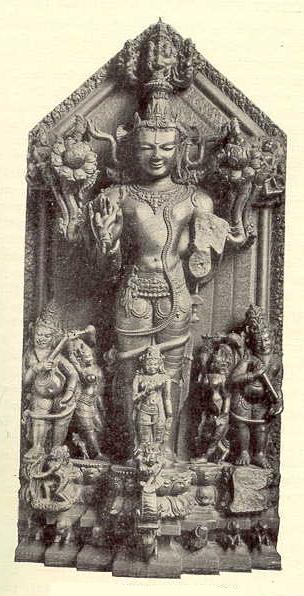
Surya, the god of sun, worshipped
daily by millions in the Gayatri Mantra. Surya has his festival
twice a year at
Lolarkakhund.
***
One of the most ancient sites in Benares.
Three giant
stairways lead steeply down to a well which was in the shape of
a keyhole. Sheer walls enclosed the barrel part, which from the
top looked like any other well.
First mentioned in the Rig Veda. This
is the most southerly of the twelve sun shrines along the Ganga
at Benares. It’s incredible that the ancient Indians could
have exercised such scientific precision.
Each of the
twelve marks the exact spot of the cusp between one zodiacal
sign and the next – a time which in India is considered highly
potent a and auspicious. Recent
astronomical observations have shown the setting to be
absolutely correct. In June the sun is directly
overhead the middle of this well, and that is the most sacred
time for this Surya shrine. Surya, the god of sun, worshipped
daily by millions in the Gayatri Mantra. Surya has his festival
twice a year.
(source:
Travels
Through Sacred India - By
Roger Housden p. 124).
Top
of Page
Akshardham
Temple attack was planned in Riyadh (Saudi Arabia)
 In
a startling development, the Ahmedabad city crime branch
arrested five people, claimed to conspirators and executors of
the terror attack on the Akshardham
temple on September 24 last year which killed
persons. Two
of those arrested are Muslim clerics,who ran relief camps in
Ahmedabad after the riots, and it is believed that they were
picked up much earlier the week even though the police claimed
that they were picked up on Thursday night. In
a startling development, the Ahmedabad city crime branch
arrested five people, claimed to conspirators and executors of
the terror attack on the Akshardham
temple on September 24 last year which killed
persons. Two
of those arrested are Muslim clerics,who ran relief camps in
Ahmedabad after the riots, and it is believed that they were
picked up much earlier the week even though the police claimed
that they were picked up on Thursday night.
They
settled for Akshardham, because it was a crowded venue and a
soft target”. The terrorists, armed with AK 56
assault rifles, explosives and rations, entered the temple
complex right opposite the VIP enclave in Gandhinagar and
started a gunbattle that claimed 33 lives, and lasted until they
were finally killed by NSG commandos. Police
commissioner KR Kaushik told press conference that the crime
branch picked up Salim Hanif Shaikh, a resident of Dariapur who
now works in Riyadh, late on Thursday evening, which led to the
arrest of four others through the night. He said Salim provided
logistic support to the two terrorists who had come from
Pakistan.
“Preliminary
interrogation and investigation reports suggest that the attack
had been a joint operation of Jaishe-Mohammad (JeM) and
Lashkar-e-Toiba (LeT) with support from the ISI. The plot had
been hatched in Saudi Arabia and discussed at Hyderabad (Andhra
Pradesh) after last year’s communal violence,” asserted
Kaushik.
(source: Akshardham
attack was planned in Riyadh - timesofindia.com).
For more on Akshardham Temple refer to chapter Glimpses
IV).
Top
of Page
Shyamji
Krishna Verma (1857 - 1930) - Noted freedom fighter
 The
important personality in the revolutionary movement for freedom
of india, Shyamji Krishna Verma was born on 4th Oct. 1857 in
village Mandwa. Maharishi Dayanand inspired him to go abroad for
study and was the first indian graduate from Oxford University.
He held important jobs like minister and chief minister at
Ratlam, Udaipur and Junagarh states. In 1905 he established
India Home Rule Society to work for freedom of india. He
inspired Bhai Parmanand, Lala Hardayal and veer Savarkar for
revolutionary struggle for freedom. Shyamji Krishna Verma
expired on 31st March 1930. The
important personality in the revolutionary movement for freedom
of india, Shyamji Krishna Verma was born on 4th Oct. 1857 in
village Mandwa. Maharishi Dayanand inspired him to go abroad for
study and was the first indian graduate from Oxford University.
He held important jobs like minister and chief minister at
Ratlam, Udaipur and Junagarh states. In 1905 he established
India Home Rule Society to work for freedom of india. He
inspired Bhai Parmanand, Lala Hardayal and veer Savarkar for
revolutionary struggle for freedom. Shyamji Krishna Verma
expired on 31st March 1930.
A contemporary of Madame
Bhikaji Cama and Sardarsingh
Rana, he inspired leaders like Bhai
Parmanand, Lala Hardayal and Veer
Savarkar. Verma is said to have arranged Netaji
Subhash Chandra Bose's secret submarine passage from
Germany to Japan during India's freedom struggle.
Verma
had raised the voice of India for Independence in the last
decade of the 19th century, a full 25 years before Gandhiji came
onto the Indian scene. It is
regrettable that even 50 years after Independence, the nation
did nothing to honour this great Indian whose scholarship and
political activism are universally recognised.
In fact, even
the idea of satyagraha came from him much before Gandhiji
developed it into political action. He wrote in 1905: “It is
not necessary for Indians to resort to arms for compelling
England to relinquish its hold on India... If the brown man
struck work for a week, the Empire would collapse like a house
of cards... If anyone refused to buy or sell any commodity, or
to have any transaction with any class of people, he commits no
crime known to the law. It is, therefore, plain that Indians can
obtain emancipation by simply refusing to help their foreign
master without incurring the evils of a violent revolution.”
Thus there is
no doubt that it was Shyamji who first
advocated non-violent means of getting rid of the British and
using withdrawal of cooperation with the colonial administration
as the most effective weapon for this purpose.
Gandhiji built on this and evolved satyagraha as a tool to oust
the British much later.
(source: Independence
Initiative
- By Balbir Punj - timesofindia.com).
Modi
brings ashes of Indian revolutionary back from Geneva
It's
unfortunate that no earlier government tried to fulfill Verma's
wishes,"
Modi, the chief minister of Verma's home state of Gujarat said. Hundreds
of supporters turned out for the urn's procession through
Bombay, chanting "Long live Verma!" The urn will be
taken around western India before being interred in December in
Verma's hometown Mandvi in Gujarat.
(source:
http://www.gujaratindia.com/Events/1714(1).htm
).
Top
of Page
Masada and
Ancient India
Israel - A Natural ally
On
the 15th of Xanthicus (roughly, April), AD 74, Eleazer
ben Yair, the son of Judah the Galilean and leader of
a Jewish community besieged by invading
Romans in
their rock fortress of Masada,
rose to address his people. He had a simple message: There would
be no surrender. They would all have to die, kill each other,
with the last man killing himself.
 Eleazer’s
listeners demurred. Sensing their fear, the charismatic leader
rose again, to deliver a final exhortation. Eleazer’s
pulsating tour de force was not about Israel, the Jewish faith
and the barbarians at the gate. Eleazer’s
listeners demurred. Sensing their fear, the charismatic leader
rose again, to deliver a final exhortation. Eleazer’s
pulsating tour de force was not about Israel, the Jewish faith
and the barbarians at the gate.
It
was, the historian Josephus was to later record, an evocation of
the Hindu rite of passage, of seeing death in the flesh as just
another milestone on the soul’s immortal journey. ‘‘Are we
not,’’ Eleazer asked, ‘‘ashamed to have lower notions
than the Indians? And by our own cowardice?’’
"We, therefore, who have
been brought up in a discipline of our own, ought to become an
example to others of our readiness to die. Yet, if we do stand
in need of foreigners to support us in this matter, let
us regard those Indians who profess the exercise of
philosophy; for these good men do but unwillingly undergo the
time of life, and look upon it as a necessary servitude, and make
haste to let their souls loose from their bodies; nay,
when no misfortune presses them to it, nor drives them upon it, these
have such a desire of a life of immortality, that they tell
other men beforehand that they are about to depart; and nobody
hinders them, but every one thinks them happy men,
and gives them letters to be carried to their familiar friends
[that are dead], so firmly and certainly do they believe that
souls converse with one another [in the other world]. So when
these men have heard all such commands that were to be given
them, they deliver their body to the fire; and, in order to
their getting their soul a separation from the body in the
greatest purity, they die in the midst of hymns of commendations
made to them; for their dearest friends conduct them to their
death more readily than do any of the rest of mankind conduct
their fellow-citizens when they are going a very long journey,
who at the same time weep on their own account, but look upon
the others as happy persons, as so soon to be made partakers of
the immortal order of beings. Are not we, therefore, ashamed to
have lower notions than the Indians? and by our own cowardice to
lay a base reproach upon the laws of our country, which are so
much desired and imitated by all mankind?"
For more refer to Wars
of the Jews
- By
Flavius Josephus
(source:
Hail
Mogambo
- By Ashok Malik - indianexpress.com and Josephus:
Wars of the Jews.,
Book VII, Chapter VIII, section vii).
For
more refer to chapter on Greater
India: Suvarnabhumi and
Sacred
Angkor
Top
of Page
Queen's
Bravery at Chittor

The Rani
Padmini and her entire entourage of women, slid their farewells,
and singing ancient hymns, boldly entered the mahal and
performed jauhar.
Refer
to chapter on Islamic
Onslaught
***
Sacks of Chittor: In 1303 Allauddin
Khilji, Sultan of Delhi, intrigued
by tales of the matchless beauty of Padmini, Rani of Chittor,
of her wit and charm, decided to verify this himself. His armies
surrounded Chittor, and the sultan sent a message to Rana
Rattan Singh, Padmini's husband, to say that he would
spare the city if he could meet its famous queen. The compromise
finally reached was that the sultan could look upon Padmini's
reflection if he came unarmed into the fort. Accordingly, the
sultan went up the hill and glimpsed a reflection of the
beautiful Padmini standing by a lotus pool. He thanked his host
who courteously escorted Allauddin down to the outer gate-where
the Sultan's
men waited in ambush to take the rana hostage.
There
was consternation in Chittor until Padmini devised a plan.
A messenger informed the sultan that the rani would come to him.
Dozens of curtained palanquins set off down the hill, each
carried by six humble bearers. Once inside the Sultan's camp,
four well-armed Rajput warriors leaped out of each palanquin and
each lowly palanquin bearer drew a sword.In the ensuing battle,
Rana Rattan Singh was rescued-but 7,000
Rajput warriors died. The sultan now attacked Chittor
with renewed vigor. Having lost 7,000 of its best warriors,
Chittor could not hold out. Surrender was unthinkable. The
rani and her entire entourage of women, the wives of generals
and soldiers, sent their children into hiding with loyal
retainers. They then dressed their wedding fine, slid their
farewells, and singing ancient hymns, boldly entered the mahal
and performed jauhar.
(source: Bravery
at Chittor - http://www.rajasthaninfoline.com/rinfo/chittorgrahh.htm).
Top
of Page
The
Battle for Indonesia
Distance
from Islam's Arab heartland, in time as well as space, imbued
Indonesia's version of the religion with an eclecticism absent
in converted lands closer to the first flush of Arab power.
As
the anthropologist Clifford Geertz
has said: "In Indonesia, Islam did not construct a
civilization, it appropriated one."
Preceded
by nearly a millennium and a half of Hinduism and Buddhism,
Islam evolved here as a mélange of core Islamic beliefs and
older Hindu-Buddhist customs that bore little resemblance to the
desert faith of Yemenis, Iraqis or Syrians. In "The Year of
Living Dangerously," set in the mid-1960s, the dwarf
photographer Billy Kwan
explains this to his colleague, an Australian journalist fresh
off the boat: "Spiritually, this
place is still a colony -- not of Holland, of Hindustan. It's
the old Hindu kingdoms that are most real here."
By
the mid-'80s, Arab names began to edge out their Sanskrit
predecessors in kindergartens. (Note that Megawati,
the president's name, is Sanskrit for "Lady of the
Clouds." Indonesia is the only Muslim country in which a
pre-Islamic nomenclature stubbornly survives,. Underlying
all this is the cultural cringe of the convert, most acutely
documented by V.S. Naipaul in his "Beyond Belief: Islamic
Excursions Among the Converted Peoples." Indonesian
Islamists who wax lyrical about Muslim Spain fall silent when it
comes to the grandeur of Indonesia's own (pre-Islamic) Majapahit
empire.
(source:
The
Battle for Indonesia -
By Sadanand
Dhume
-
Wall Street Journal - August 11 2003).
***
Ancient Ganesh in Indonesia
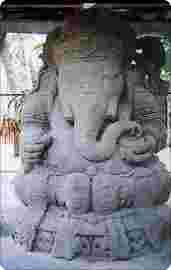 Ganesh
Chaturthi is one of the biggest festivals held every year in
Maharashtra. The Ganesh itself that makes this festival a
mammoth one. A journey to ancient Hindu-influenced parts of this
world which almost all of them reside in Southeast Asia reveals
the fact. Ganesh
Chaturthi is one of the biggest festivals held every year in
Maharashtra. The Ganesh itself that makes this festival a
mammoth one. A journey to ancient Hindu-influenced parts of this
world which almost all of them reside in Southeast Asia reveals
the fact.
Just like in Cambodia, Vietnam,
and some other Southeast Asian countries, Hinduism was a big
part of the beliefs of Indonesians. Decrepit and remnants of
more than 300 years (some are more than 1000 years) aged temples
found and excavated in Indonesia. There located prominent Ganesh
statues. Most of them are still intact and preserved in museum
and some are still on their places where they were placed more
than one hundred decades ago. There are
at least more than 15 spots all over Indonesia where Ganesh
statues were found.
Ganesha was extremely popular in
the art of Indonesian islands, especially of Sumatra and Java
and compare favorably with the eighth-century Ellora caves, in
images, style and iconography. At Candi
Sukuh in central Java, a remarkable fifteenth century
relief shows three figures, with a dancing Ganesha in the
centre.
There are paintings and stone
sculptures of the deity found in China,
apart from the textual references to Ganesha in the Chinese
Buddhist canon.
The worship of Rishi Agastya, the
sage responsible for the diffusion of Hindu culture in Java, the
frequent occurrence of Ganesha images, the
organization of rural economy and village administration, the
shadow and puppet plays and Vedic hymns and rituals of Bali, all
point to the extension of Indian religious and cultural
influences of these islands. A statue of Agastya is found at
Candi Banon - early 9th century Batavia)
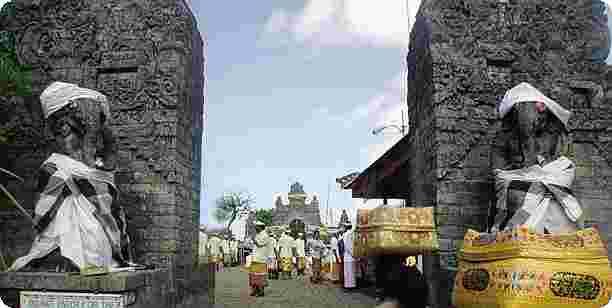
Ganesha Statues
at Pura Luhur Uluwat in Bali
***
(source:
Ancient
Ganesh in Indonesia - esamskriti.com).
For
more refer to chapter on Greater
India: Suvarnabhumi and
Sacred
Angkor
Top
of Page
Jews
chant Hare Rama Hare Krishna on Janmashtami
Harish (Israel): Janmashtami has been
celebrated with much fanfare in this small town in the north of
Israel, with devotees thronging the place from all parts of the
country chanting Hare Krishna, Hare Rama.
The small township has attracted the attention of the devout,
who have formed a small community and settled down here in
isolation from the mainstream. All the
followers are Jews, most of whom came in touch with the
Vaishnava ideals during their visit to India and have started
practicing them rigorously.
On the occasion of the birth of the lord they staged plays
revolving around stories of Krishna's childhood, besides singing
and dancing late into the night just like the bhaktas in India.
They also served 108 delicious dishes, a number that has come to
be attached with the faith.
The followers of the group also frequent Vrindavan and Mayapuri,
in India every year.
First secretary, Subrata Das, present on the occasion called the
occasion "another manifestation of
the strengthening Indo-Israeli cultural ties".
(source:
Jews
chant Hare Rama Hare Krishna on Janmashtami - newindpress.com).
Top
of Page
Murderous
Monday - Twin Blasts in Mumbai
Bomb
blasts rip through Mumbai in replay of 1993. It
was a horrifying reprise of 1993. Now, as then, the murderous
bomb blasts which rocked Mumbai on Monday seemed to be
well-planned and co-ordinated to inflict maximum damage on the
city’s symbols of civic pride and financial power. Is
it merely coincidental that the attacks have taken place at a
time when the Indian stockmarkets had entered a bullish phase
for the first time in two-and-a-half years? The targets chosen
were Zaveri Bazar, the gold and diamond bourse which is close to
the Mumba Devi temple from which the city derives its name; and
the Gateway of India. These densely populated areas
were obviously chosen so as to ensure maximum number of
casualties.
Police put the death toll at 46,
but hospital officials said 48 had died. At least 153 people
were wounded, according to hospital officials. The
carnage shocked even to those accustomed to bloodshed. "I
have never seen anything so horrible," said S. Manoj, a
doctor at Bombay's J.J. Hospital. "It was just body parts,
some with their abdominal organs hanging out, some with no faces
at all. The bodies were all burnt."
100
detonators found near Nasik

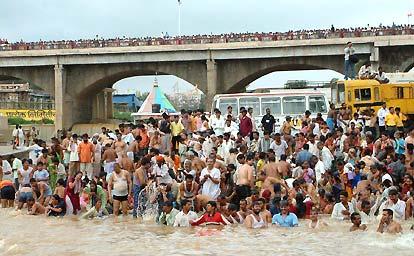
100
detonators found near Nasik.
***
Hours after twin car bomb blasts
in Mumbai killed 46 people, more than 100 detonators were
recovered from a railway track at a place about 60 km from here
just an hour before an express train
carrying mostly Kumbh pilgrims was to pass, senior police and
railway officials here said. Hours
later, nine mine detonators were found on a railway track on a
major line 85 kilometers (about 50 miles) north of Mumbai at
Kafara, said Chhagan Bhujbal, provincial home minister. The
detonators were planted on a line to the city
of Nashik, where a major Hindu festival is under way
through Wednesday.
World
condemns Mumbai blasts -
Bombings
'senseless and cowardly': US
The United States has publicly condemned the twin bomb blasts in
Mumbai that killed 46 people and injured over 150 as 'senseless
and cowardly terrorist attacks'. US, Britain and Germany on Monday
strongly condemned the car bombings in Mumbai and expressed
their firm determination to fight the scourge of international
terrorism. US Secretary of State Colin Powell, on vacation on
Long Island, New York, called External Affairs Minister Yashwant
Sinha and expressed his "outrage
at these senseless and cowardly terrorist bombings".


There
is a tendency, distressingly familiar among the global
fraternity of liberals, to shy away from facing awkward
realities. India is no exception to this escapism.
***
There
is a tendency, distressingly familiar among the global
fraternity of liberals, to shy away from facing awkward
realities. India is no exception to this escapism. In
the aftermath of the two bomb blasts that killed at least 50
people and injured another 160 in the center of Bombay --
India's largest city and the nerve center of its entrepreneurial
culture -- there are some self-serving explanations doing the
rounds. The first is that Monday's explosions constitute the
militant Muslim reaction to the riots in Gujarat in March 2002. More
bizarre is the suggestion that they coincided with the release
of a report by the Archaeological Survey of India suggesting
that a 10th century Hindu temple predated a 16th century mosque
demolished by Hindu activists in 1993.
Compelling
as these theories are, they willfully
skirt a grim phenomenon -- the expansion of Islamist terror
networks into the heart of India. Monday's fierce
explosions in Bombay were not isolated occurrences. They were
preceded by five blasts, the first on Dec. 2 last year, that
have killed 17 people and injured 189.
(source:
Islamist
Terror Comes To India’s Streets
- By Swapan
Dasgupta - Wall street
Journal - August
27, 2003). Refer
to Kashmir Holocaust
http://www.hinduhumanrights.org/kashmirspecial.pdf.
Refer to
My
People, Uprooted: "A
Saga of the Hindus of Eastern Bengal"
- By Tathagata Roy
***
Alex
Perry of Time
magazine justified the attack by saying:
"As
Bombay suffers the latest in a string of deadly bomb blasts,
suspicions focus on domestic Muslim
terrorists enraged by Hindu nationalism. The same
years old anti-India attitude, The same
justifying promotion of "Jihad" as "response,
reaction" to "Hindu-nationalism" under the phrase
"domestic Muslim terrorists enraged by Hindu
nationalism" (Do terrorists have
right to be enraged by a nationalism?).
(source: Indiacause.com).
Columnist
Talveen
Singh writes: "Because
most of us of the secular, liberal, mainstream media do not dare
say the words Islam and terrorism in the same breath.
In
the wake of the Mumbai blasts, a great
deal of poorly informed 'analysis', both in the Indian and the
international media, sought to link the incidents to proximate
triggering events including, among others, the Gujarat
riots last year and the disclosure of a report by the
Archaelogical Survey of India, on the very morning of
the twin explosions in Mumbai, which claimed that 10th century
temple lay under the foundations of the disputed Babri Masjid
(mosque) site in Ayodhya, Uttar Pradesh. These
analyses fail to comprehend the sheer enormity of the Islamist
enterprise in South Asia, the continuity of motives
that underlie a long succession of incidents, and the complexity
and number of cells and networks that have been established
across the country to secure a sustained and subversive
strategic agenda'. I could not agree more. On
account of political correctness and some bizarre idea that you
become anti-secular if you criticize anything Islamic we in the
media rarely have the courage to admit that nearly every act of
terrorism on Indian soil in the past ten years has been Islamist.
We
also rarely have the courage to admit that the worldwide Islamic
jehad has India, second only to America and Israel, as
"enemy number one".
(source: Subversive
acts on Indian soil - By Talveen Singh). Watch History
of Ayodhya - videogoogle.com. Refer
to Kashmir Holocaust
http://www.hinduhumanrights.org/kashmirspecial.pdf
Top
of Page
If
we rationalise terror, can we fight it?
"Islamic
terror comes to the streets of India." This is how Swapan
Dasgupta captured the latest terror attack in Mumbai in Wall
Street Journal. The attack
has claimed 52 lives. The wounded may still swell the
list of dead. In ten terror strikes on Mumbai in last one year
more than 100 persons have perished. Yes, Pakistan wants India
destabilised, even dismembered. Not just that. Last week, a BBC
analyst said that Pakistan's agenda is not limited to a part of
Kashmir. Or even the whole of it. It aims at larger India,
targets at Islamising it.
Look
at our public discourse. Even naming Pakistan as the terror
merchant is seen as politically incorrect. Some `intellectuals'
even say it is not Pakistan, but, the oppression of
minorities in India by VHPs which activates terror against
India! How reckless? Why then does
Islamic terror strike at Pakistan, at the US, at Russia, at
Indonesia, and at the rest and even at Saudi Arabia where no VHP
is inviting them to strike? Yet, they counsel,
terrorists are not to blame. No terror, just the angry
acts of the oppressed, they conclude. This is secular politics.
In short, they rationalise terror itself. If we rationalise
terror, can we fight it. We
cannot. That is why we do not.
(source:
If
we rationalise terror, can we fight it? -
By S Gurumurthy - newindpress.com).
Top
of Page
Hindu
Cowardice and Gandhian Non-Violence
The famous quotation of Mahatma
Gandhi on Hindu cowards and Muslim bullies deserves to be read
in full:

Maharana Sheer
- King of Rekah
(image source: Annals
and Antiquities of Rajasthan: or the Central and Western Rajput
States of India - By
Colonel James Tod).
***
"There is no doubt in my
mind that in the majority of quarrels the Hindus come out second
best. But my own experience confirms the opinion that the
Mussalman as a rule is a bully, and the Hindu as a rule is a
coward. I have noticed this in railway trains, on public roads,
and in the quarrels that I had the privilege of settling. Need
the Hindu blame the Mussalman for his cowardice? Where there are
cowards, there will always be bullies. They say that in
Saharanpur the Mussalmans looted houses, broke open safes and,
in once case, a Hindu woman's modesty was outraged. Whose fault
was this? Mussalmans can offer no defence for the execrable
conduct, it is true. But I, as a Hindu, am more ashamed of Hindu
cowardice than I am angry at the Mussalman bullying. Why did not
the owners of the houses looted die in the attempt to defend
their possessions? Where were the relatives of the outraged
sister at the time of the outrage? Have they no account to
render themselves? My non-violence does not admit of running
away from danger and leaving dear ones unprotected. Between
violence and cowardly flight, I can only prefer violence to
cowardice."
(source: Hindu-Muslim
Tension: Its Causes and Cure - Young India -
29/5/1924; reproduced in M. K. Gandhi: The Hindu Muslim Unity p.
35-36 and Bharatiya
Janata Party vis-a-vis Hindu Resurgence - By Koenraad Elst
p. 44).
***
Gandhi and
Israel
Israel
and India have in common: two ancient cultures that bucked
British rule at about the same time (1948 and 1947) and founded
democratic islands in oceans of
authoritarian regimes.
Mahatma Gandhi
himself was opposed to the creation of the state of Israel.
"Why should [Jews] not, like
other peoples of the earth, make that country their home where
they are born and where they earn their livelihood?" he
argued in 1938.
(source: India
and Israel vow to fight terrorism - BBC News.com).
For more on Gandhi and the Jews refer to chapter GlimpsesVI).
Top
of Page
Seek India's
support - says Jerusalem Post
"India,
America, and Israel are all targeted by the terrorist scourge,
and ought to develop "multilateral mechanisms to counter
it... Such an alliance would have the political will and moral
authority to take bold decisions in extreme cases of terrorist
provocation... It would not get bogged down in definitional and
causal arguments about terrorism."
They
powerfully contrast with the equivocation exhibited by Western
Europe.
It's
against this backdrop that Ariel Sharon sets off on Monday on
the first state visit to India by an Israeli premier. The visit
is regarded as a milestone both here and in India the first of
its kind since the establishment of full diplomatic relations in
1992. It will mark the achievement of a new dimension in
bilateral relations, now coming to full bloom, turning India
into one of Israel's main allies.
The 1991 Gulf War reduced Arab clout and led to a dialogue with
Israel. On January 29, 1992, Prime Minister Narasimha Rao
overruled objections and normalized relations with Israel. Close
ties have proved mutually beneficial, underscored by the fact
that both countries boast ancient cultures and vibrant
democracies. There has long been a
minuscule Jewish presence in India, happily encountering no
anti-Semitism. Finally, both countries face the
ongoing threat from fanatic Muslim fundamentalism and terrorism.
In absolute numbers more Indians have been murdered in terrorist
atrocities than in any other country.
(source:
Seek
India's support - Jerusalem Post.
For more on Indian Jews refer to chapter GlimpsesVI).
 Israel
supported India during the 1962 conflict with China and then
again during the 1965 war with Pakistan at a time when no formal
diplomatic relations, other than a sole Israeli
consulate in Mumbai, existed between the two countries. Despite
the compulsions of Cold War and the intense pressure from Arab
quarters, Indira Gandhi ensured its continuity. Israel
supported India during the 1962 conflict with China and then
again during the 1965 war with Pakistan at a time when no formal
diplomatic relations, other than a sole Israeli
consulate in Mumbai, existed between the two countries. Despite
the compulsions of Cold War and the intense pressure from Arab
quarters, Indira Gandhi ensured its continuity.
Israel
earned big points with New Delhi when, during Kargil, it sent
over the laser-guided missiles that allowed India's Mirages to
bust Pakistan's bunkers.
Jason
Isaacson, who heads the American Jewish Committee's Washington
office, described India
and Israel as democracies surrounded by “hostile neighbours,
well armed and numerous.”
He said it made sense to jointly work on issues where both
countries stood to benefit.
Indo-Israeli
give and take - By Ashok K Mehta
India cannot expect to win the
war against terror by simply importing technology and
techniques. It has also to produce a
stock of political will and killer instinct, the stuff which is
not in the Indian genes and without which terror can only be
fought without hurting the enemy.
(source: Indo-Israeli
give and take - By Ashok K Mehta
- dailypioneer.com
Tuesday September 9' 2003).
Why
India and Israel joined forces
Shimon
Peres is the traditional torchbearer of the India flame. Peres
shared the belief of Israel's founding father, David Ben-Gurion,
that what Indians thought of Jews would be crucial to the Jewish
race's future.
(source:
India seduces warrior Sharon - By Pramit
Pal Chaudhuri - hindustantimes.com September
11, 2003).
Monday
Israeli Prime Minister Ariel Sharon is due in India for a brief
official visit, the first by an Israeli prime minister. It
is a visit Israeli officials could only dream of during their
country's first 40-odd years. Both
countries won independence from Britain within nine months of
each other. India became independent on Aug. 15, 1947, and
Israel on May 15, 1948. Both are relatively stable, democratic
states in an area that is not known for democracy, nor political
stability. Both face Muslim enemies, and both have
large Muslim minorities.
Pakistan -- India's nuclear
neighbor -- has warned the growing
alliance between Israel and India carries
"dangerous consequences," saying that the trip to
intensify defense cooperation with its nuclear rival could
destabilize the region.
Secular
establishment and their cheer leaders in the Muslim
fundamentalist sections oppose Sharon's visit
“They should explain why
comrade Jyoti Basu visited Israel. Deve Gowda, who
had high level interactions with Israel in Davos should explain
why he is opposing prime minister Sharon’s visit,” he said.
(source:
Why
India and Israel joined forces
- By Joshua
Brilliant - United Press International
and Sharon
begins historic visit to India - cnn.com and Leftspeak:
Visit Tel Aviv, but slam Sharon trip - economictimes.com).
Top
of Page
US
seeking new ally in Hinduism, claims scholar
After
September 11 attacks in the US, Christian groups in the West are
keen on an alliance with Hindu forces, claims an Indian scholar
teaching in Florida. Director
of the Bangalore-based International Sanskrit Research Academy,
BV Venkatakrishna Sastry who teaches "spiritual
linguistics" at the Hindu University of America in Orlando,
Florida, claimed that there was a growing awareness of Hinduism
in the "administrative circles" in the US.
"The
evangelical Christian movement, the driving force of the US
administration, is looking at what kind of allies they should
have for a regional and administrative balance," Sastry,
49, said.
"After
the attacks, it is felt that those with an Islamic faith
background will not suit the administrative approach of the US.
So, the driving thrust is on Judaism, because of the situation
in Palestine, and on the Asian side, Hinduism."
Noting the two predominant religions in Asia, Hinduism and
Buddhism, he said that since a large number of Buddhists are
from China they are ruled out as American allies because of
ideological, cultural and economic differences. "That
leaves Hinduism, which is more acceptable because of several
factors."
Further,
English is spoken everywhere in the subcontinent and
communication with the US poses no problem.
"Technology
wise too, India has a leading edge," Sastry said. "
IIT graduates are feeding intellectual research abroad. Besides,
Indian legacies such as yoga
and ayurveda
are widely regarded as alternative medicines and sources of
spiritual healing."
(source:
US
seeking new ally in Hinduism, claims scholar
- hindustantimes.com).
Top
of Page
Indian
diamond traders unseating Jews: Wall Street Journal
 Indian
diamond traders are progressively displacing the Jewish
community that dominated this trade in Belgium's diamond city -
Antwerp, and are now calling for better representation on
Antwerp's High Diamond Council, the powerful regulatory body in
the trade, according to the Wall Street Journal. Indian
diamond traders are progressively displacing the Jewish
community that dominated this trade in Belgium's diamond city -
Antwerp, and are now calling for better representation on
Antwerp's High Diamond Council, the powerful regulatory body in
the trade, according to the Wall Street Journal.
The
lower cost production in Mumbai and Gujarat has helped Indians
takeover the trade that was once the preserve of Antwerp's
Jewish neighbourhood.
The
Journal ran a lengthy feature article entitled
"Indians Unseat Antwerp's Jews As the Biggest Diamond
Traders", a colourful piece that shows how Indians (mainly
Gujaratis) in Armani suits haggling with Hasidic Jews in long
black coats and side curls, have the same business traits and
practices and have come to trust each other in the market for
the precious stones.
"Hoveniersstraat,
a street once celebrated for its kosher restaurants, now offers
the best curry in town," notes the Journal, as
versatile Indian businessmen who are famous for changing with
the times and breaking into markets that have been strongholds
of other communities.
"Indians
are among the world's most successful newcomers. They
have reinvigorated the jewellery districts in New York and Hong
Kong and revived the US motel industry; they are among the
programmers of choice in Silicon Valley and Berlin.
In the global diamond world, Indians have been so successful
that they are challenging Jewish dealers, even in Tel Aviv.
About 80 per cent of all polished diamonds sold worldwide pass
through Indian hands," notes the Journal.
Indians
hold 65 per cent of the $26 billion business while Jews have
been reduced to holding 25 per cent of it where once they
controlled 70 per cent of revenues.
Instead
of the air of a traditional Jewish village, the trading area
seems more and more like Mumbai, the Journal says. But at heart,
say some Indian traders, the Jain and Jewish cultures share many
qualities.
"Both
value kinship, hard work and cross-border networking, useful
qualities in a global industry that depends on wheeling and
dealing."
While
Indians sent their rough diamonds to be finished in family-owned
factories in Mumbai and elsewhere, the Jews did not search out
the cheaper alternatives. India also has a long history of
diamond trading. "India, where the
world's first diamonds were discovered in 800 BC, provided most
of the world's supply until the 18th-century diamond rushes in
South Africa and Brazil."
(source: Indian
diamond traders unseating Jews: WSJ
-
timesofindia.com May 29
2003).
Top
of Page
The Knowledge
of Brahman - By Sri Ramakrishna
Brahman is beyond vidya and
avidya, knowledge and ignorance. It is beyond maya, the illusion
of duality. The world consists of the illusory duality of
knowledge and ignorance. Good and evil apply to the jiva,
the individual soul, as do righteousness and unrighteousness.
But Brahman is not at all affected by them.
One man may read the Bhagavad
Gita by the light of a lamp, another may commit a
forgery by that very light. The lamp is unaffected. The sun
sheds its light on the wicked as well as the virtuous. What
Brahman is cannot be described. In Samadhi one attains the
knowledge of Brahman, one realizes Brahman. In that state
reasoning stops altogether, and man becomes mute. He has no
power to describe the depth of the Brahman.
(source: The
Knowledge of Brahman - By Sri Ramakrishna - The
Spirit of Modern India - Edited by Robert A McDermont and V.
S. Naravane p. 15-16).
Top
of Page
Om
Ganesya Namah

This festival is celebrated in
the month of avani on chaturthi (4th) day (31-8-2003) which
comes after the new moon. It is celebrated all over India.
People celebrate this day in a variety of ways. For
anything to go well, we pray Lord Vinayaka. He is the first to
be worshipped whenever we start anything. He relieves us from
all our difficulties. He solves our problems.
Lord Vinayaka has got an
elephant face and human body. He is worshipped by many names
like Vinayaka, Ganesha, Pillayar, Vigneshwara, Gajanana,
Ganapathy, Mooshika Vahanaa, Modhaga priya etc. He rides on an
animal called mooshika(a large kind of rat).
In our houses we celebrate this
pooja in a grand manner. We decorate the floor with kolams using
rice flour. On that day we buy a new Vinayaka idol(made of
clay). We also buy a decorated umbrella to place behind the
idol. On a wooden plank, plantain leaf is placed and raw rice is
spread over it. We place the idol on this and decorate with
flowers and perform pooja.
 Vinayaka
likes a dish (appam) called mothagam. So different
varieties of appams are prepared and offered to the lord on
this day. It is the special item on this day. Vinayaka
likes a dish (appam) called mothagam. So different
varieties of appams are prepared and offered to the lord on
this day. It is the special item on this day.
On the next day, punar pooja is
done. This is the pooja which acts as an ending to the festival.
After this we remove the idol from its place. On the next day
after punar pooja, we immerse the idol in water in the sea, well
or pond.
In cities like Mumbai, Chennai
etc. large Ganesha idols (a bout 6 ft) are placed in common
places and pooja is performed in a very grand manner. People all
around worship the lord. Prasadams (Dish offered to the lord)
are distributed to the people. After the pooja is over, the idol
is taken in a grand procession and immersed in the sea.
For this pooja, different flowers
are used. Erukkampoo(calotropis), thumbaipoo(white small flowers
and arugampul( a type of grass name karuka) is very special for
the lord. Different varieties of fruits are also offered.
(source: Om
Ganesya Namah -
Contributed by M P Bhattathiry).
It was in Pune
that Lokmanya Bal Gangadhar Tilak gave life to the concept of
sarvajanik (community) Ganeshotsav.
Ganpati Bappa Morya (Farewell O Lord Ganpati!)
Gheema ladu choriya (Who avails laddoos soaked in ghee)
Pudcha varsi laukariya (Return in haste next year)
Bapa Moriya re, Bapa Moriya re (O Lord farewell, O Lord
farewell...)
Top
of Page
Crusader
for a river
From
learning Hath yoga to alleviate his childhood ailments to
campaigning for Europe’s last preserved natural river —
Vistula — Jacek Bozek has
come a long way. Jacek, now 43, believes that his life’s
course has indeed been wayward.
 As
he grew up in his hometown Bielsko-Biala in southern Poland,
Jacek started finding ways to tackle his sickness. He chanced
upon books on Hath yoga and
even as a young boy of 14, he found them interesting. He started
practicing the postures described and over a period of time, he
mastered them to perfection. His physical and mental faculties
became strong.
Besides
books on Hath yoga, Jacek also read books on Indian
spirituality. "Vivekanand and Ramakrishna impressed me a
lot," says Jacek. He adds, "For me, Indian
spirituality was very interesting because it was profound but at
the same time very clear and simple." From the teachings of
the Hindu spiritual leaders, he realised that he had a duty to
perform. He opened his eyes to the injustice and
confusion around him. His "understanding of life"
developed As
he grew up in his hometown Bielsko-Biala in southern Poland,
Jacek started finding ways to tackle his sickness. He chanced
upon books on Hath yoga and
even as a young boy of 14, he found them interesting. He started
practicing the postures described and over a period of time, he
mastered them to perfection. His physical and mental faculties
became strong.
Besides
books on Hath yoga, Jacek also read books on Indian
spirituality. "Vivekanand and Ramakrishna impressed me a
lot," says Jacek. He adds, "For me, Indian
spirituality was very interesting because it was profound but at
the same time very clear and simple." From the teachings of
the Hindu spiritual leaders, he realised that he had a duty to
perform. He opened his eyes to the injustice and
confusion around him. His "understanding of life"
developed
He
felt that Ganga can also be depolluted like the Vistula. While
on his third visit to India with his wife Beata, Jacek, who
incidentally is a vegetarian, gave a mantra to save Ganga: Make
use of Ganga’s spiritual connotations. He admitted that
India’s path to clean Ganga river is much more easier that it
was to clean Vistula. "We do not have such deep spiritual
connections with river like people in India have. Ganga is
regarded as a mother and goddess in India as if it is a living
entity. So, why not make use of these religious sentiments to
purify Ganga once again," Jacek emphasises. Is anybody
listening?
(source:
Crusader
for a river - By Tirtho
Banerjee
-
Tribuneindia.com).
Top
of Page
Take a bow,
Mother India!
Two
separate events made me swell with pride over the past
week.
One,
Prime Minister Atal Bihari Vajpayee's eight day trip to Germany,
Russia and France. Particularly the last two nations. And
two, India's decision to pre-pay Rs 7,490 crores worth of
external debt over this fiscal year and the next....A
nuclear power. A burgeoning economy, strong enough to actually
reject aid. The political confidence to differ with and talk to the
world's sole superpower as an equal, rather than as a client
state. And the courage and conviction to chart and carve
its own route.
This
is an India no one could have dreamt of a decade ago.
(source:
Take a bow, India - by Ramananda
Sengupta - rediff.com).
Top
of Page
The Matrix of Indian philosophy
Reloaded - By Nikita Doval
 Imagine. The world is an
illusion. The universe is composed of computer codes... a
virtual fantasy force fed to us. The most over-analysed film
since film critics were invented, The
Matrix: Reloaded abounds
with theological references. Christianity, Hinduism, Buddhism...
all jostle for space, even as a hefty dose of Greek philosophy
is also added. But the very premise on
which the movie is based – the illusory world versus the real
world – recalls the concept of 'Maya' in Hinduism. Imagine. The world is an
illusion. The universe is composed of computer codes... a
virtual fantasy force fed to us. The most over-analysed film
since film critics were invented, The
Matrix: Reloaded abounds
with theological references. Christianity, Hinduism, Buddhism...
all jostle for space, even as a hefty dose of Greek philosophy
is also added. But the very premise on
which the movie is based – the illusory world versus the real
world – recalls the concept of 'Maya' in Hinduism.
"Maya has several levels of
which illusion is one level. The basic foundation on which The
Matrix trilogy is based assumes that ours is a computer-coded
world – an illusion. In this regard, there's a parallel,"
says sociologist Ashish Nandy.
The
Vedas state that whatever is happening all around is Maya, a
dream which Lord Vishnu sees as He sleeps. Maya shields the
truth or Brahman from the self or Atman. Because Maya veils the
truth, the Atman misconstrues both the world and itself as
different from the Brahman.
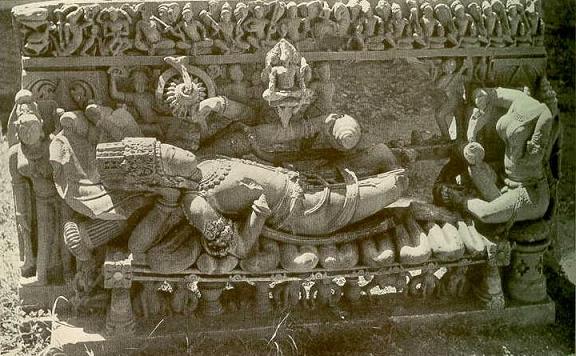
The
Vedas state that whatever is happening all around is Maya, a
dream which Lord Vishnu sees as He sleeps.
***
"Maya,
as a concept, is both fluid and unstable. It exists
but, at the same time, it is fictitious," says Imtiaz
Ahmed, professor of sociology at JNU. This explanation is
analogous to The Matrix philosophy, which states that we live in
an illusory world and only an unplugged world is real. In both The
Matrix and The Matrix: Reloaded, Neo, Morpheus and
Trinity leave the real world behind and, by computer wizardry,
enter the Matrix. But it is their mental projection that fights
all the battles.
This recalls the Vedanta
concept of mithya, the belief that only the Almighty is real.
The Vedantas say that humans live in a world of illusion and,
when we comprehend this reality, we realise that man and the
Almighty are one. It is then that man realises that his earthly
entity is just his imagination, a reflection of what he thinks
he is.
"Acceptance of the 'real
world' can be linked to the concept of Brahman — the supreme
consciousness. Sankara asserts that the individual Atman and the
universal Brahman are one and the same and the concept of a
creator who is distinct from the creation is a cosmic
illusion," says Sudarshanacharya Maharaj.
Moreover, Neo's realisation that
the world is a computer programme is compared to attaining
nirvana. In a scene in The Matrix, a boy bends a spoon by sheer
will-power and then tells Neo, "To bend the spoon, you need
to realise that there's no spoon. The spoon doesn't bend, you
yourself bend.'' When Neo realises the truth of the illusion, he
becomes omnipotent. As a consequence, he is even able to stop
bullets!
"Hinduism
propounds a similar belief. It talks about nirvana
and how, when man attains divine knowledge, he conquers all
fear, all difficulties, all pain; he experiences eternal peace,
eternal knowledge and happiness,'' says Sudarshanacharya Maharaj.
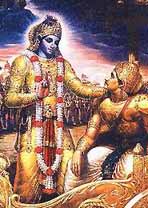 Moreover, as
with Arjuna in the Mahabharata, Neo is caught in a
dilemma at the hour of reckoning — of having to choose between
saving the world and saving Trinity. Neo chooses the latter,
deviating from his 'duty' as interpreted by Krishna in the Gita.
However, his prior exchange with the Oracle is insightful.
"You already know what choice I will make. How is it a
choice then? What if I do not choose?" he asks her.
"Even that is making a choice," she says.
"Knowledge is power — the power to make a choice. And it
is this power which helps good in its fight against evil – be
it in Mahabharata or The Matrix," says TKV Subramaniam,
dean of social sciences at DU. Moreover, as
with Arjuna in the Mahabharata, Neo is caught in a
dilemma at the hour of reckoning — of having to choose between
saving the world and saving Trinity. Neo chooses the latter,
deviating from his 'duty' as interpreted by Krishna in the Gita.
However, his prior exchange with the Oracle is insightful.
"You already know what choice I will make. How is it a
choice then? What if I do not choose?" he asks her.
"Even that is making a choice," she says.
"Knowledge is power — the power to make a choice. And it
is this power which helps good in its fight against evil – be
it in Mahabharata or The Matrix," says TKV Subramaniam,
dean of social sciences at DU.
Behind the metaphoric blitzkrieg
perforating The Matrix: Reloaded is the
unwritten word of Indian philosophy, which has influenced man
and mankind since time immemorial. Ironically, it has taken the
box-office success of a blockbuster movie based on illusion to
reload a universal truth once again.
(source: The
Matrix of Indian philosophy Reloaded - By
Nikita
Doval - timesofindia.com).
For more refer to chapter on GlimpsesIX).
For
more refer to chapter on Greater
India: Suvarnabhumi and
Sacred
Angkor
Top
of Page
Vatican
summit aims to combat threat of 'alternative' religions
Catholics
from more than 25 countries are in Rome this week to hammer out
a strategy for combating the threat
posed to Christianity by "New Age" religions and fads.
"Astrologers
believe that the Age of Pisces
- known to them as the Christian age -
is drawing to a close," explained an exhaustive
report on the New Age produced by the Catholic church last year.
And as priests around the world watch
their congregations dwindle through boredom or plain disbelief,
the Church believes that the moment has come to fight back.
Monsignor
Peter Fleetwood, one of the authors of the report, said those at
the closed-door conference include priests and lay people from
Latin America "worried that they
can be pushed out by something that has come from abroad",
and from Asia where "a lot of traditional religions are
reviving".
This
is an enemy with dozens of heads: the version of the Jewish
kabbalah espoused by Madonna, the Enneagram personality-reading
cult, ancient Egyptian occult practices, Sufism, the lore of the
Druids, Celtic Christianity, medieval alchemy, Renaissance
hermeticism, Yoga, Zen
Buddhism, and many more.
(source: Vatican
summit aims to combat threat of 'alternative' religions - By
Peter Popham -
news.independent.co.uk). for more refer to chapter on Conversion).
Top
of Page
European
sadhus too seek 'moksha'
Nashik:
' Moksha' is not the prerogative of Indians alone. It is proved
by these European sadhus who
are seen with their 'jata', 'rudraksha' and 'kamalmandelu'.
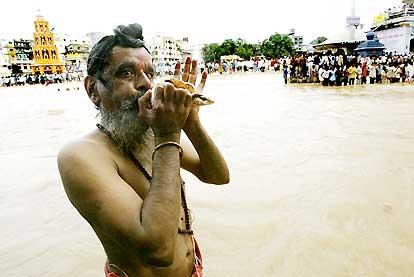
Nashik
- Kumbh Mela.
***
Dattabharati, a German sadhu,
who has come all the way from Germany on a bicycle has seen
three 'Kumbh Melas' earlier, through the 'Simhastha' at Nashik
is his first. Dattabharati left Germany about 24 years ago and
settled in Australia.
Three years ago, he witnessed the 'Mahakumbh' at Allahabad and
decided to take 'sanyas' (monk's order). He became a disciple of
Digambar Haribharati, who christened him Dattabharati. He stays
in Himachal Pradesh of the Northern India, and plans to remain
in Nashik till September.
Parmahans Sanat Sanatandas Maharaj, who
also hails from Germany, converted to Hinduism. He is
also the president of ISKON branch in Pandharpur, Maharashtra
and chief of ISKON 'Kumbh Mela' Committee. He is highly educated
and can quote from the Bhagwat Gita.
Taylor Jason Naihurt has
come all the way from Washington, US to Nashik to
study the three 'Kumbh Parve' (auspicious bathing days) for his
thesis 'Role of Sadhus in modern India'. He came has three years
ago under the rotary exchange programme. He is fluent in both
oral and written Marathi.
A five-person team of Canada's Quebec University, including its
Principal, too has come here to do the study of Kumbh Mela and
its effects on the public.
(source:
Manoramaonline.com).
Top
of Page
Shoddy
reporting in Indian newspapers
If you had been
in India in late 1998 early 1999, and the English-language
“national” newspapers had been your source of
information about what was going on, you would have concluded
that an extensive, well-coordinated pogrom was on, that maniacal
Hindu groups were going round raping nuns, attacking
missionaries, burning down churches.
Newspapers and
TV channel reported nine sets of incidents. The one that most
blackened the name of the country initially was the rape of four
nuns in Jhabua, Madhya Pradesh. The Madhya Pradesh Government
completed investigations some months ago, and arrested the
suspects. It turns out that there are as many Christians in the
wretched lot as non-Christians, and that the nuns had been
assaulted not because of any religious hatred or impulse, but
because of local animosities – two groups contending with each
other. Not one of the organizations and publications which had
pasted the rapes of Hindu fundamentalists had done anything –
not the rapes on Hindu fundamentalists has done anything – not
the littlest thing – to ensure that the accused are tried
swiftly.
“Jhabua
re-enacted in Jhajjar,” proclaimed a four-column headline of The
Hindustan Times in regard to the second incident. It
reported – on the authority of one of the chief propagandists
of Christian organizations, he also doubles up as an
editor of an afternoon paper in Delhi. No
one was molested. Neither the propagandist-Editor nor The
Hindustan Times returned to the story they had played up so
much.
The third
incident originated in a story put out by Associated Press. An
American doctor, Dr. John Sylvester, working in Allahabad has
been attacked by Hindu fundamentalists, the agency reported, he
has had to seek shelter in a Baptist Church, his clinic has been
broken up….And the facts? Sylvester is not a medical doctor,
he has a Ph.D in Economics. He is not an American, his wife is.
He has no clinic, instead he runs two schools. Neither
he nor his wife, nor their schools had ever been attacked. But
the assault was the talk in atrocity-circles: in the papers, on
Internet.
(source: Harvesting
Our Souls:
Missionaries,
their design, their claims - By Arun Shourie
p. 7 - 8 ASA
pub ISBN:81-900199-9-6).
Top
of Page
Nobody
has right to convert: Supreme Court of India
New
Delhi: There is no such thing as a
fundamental right to convert any person to one's own religion
and the government can impose certain restrictions keeping in
view public order, the Supreme Court has ruled.
The
court's ruling came while dismissing a petition challenging an
Orissa law requiring police verification of all religious
conversions. Citing the SC's landmark 1977 ruling in Rev
Stanislaus vs Madhya Pradesh, a Bench of Chief Justice V N Khare
and Justice S B Sinha said that ''what
is freedom for one is freedom for the other, in equal measure''.
 At
dispute was a 1999 provision added to the Orissa Freedom of
Religion Act, 1967, stipulating that a person wanting to convert
to a particular religion must make a personal declaration which
would be verified by the police also. Petitioner's counsel
Janardhan Das said this provision was unwarranted as it makes a
person wanting to convert to a religion of his choice a suspect
in the eyes of law. As early as 1976, the Orissa High Court had
struck down as unconstitutional the Orissa Act. It
quashed all criminal proceedings against those who were alleged
to have resorted to conversion through inducement or by
''force'' or ''fraud''. At
dispute was a 1999 provision added to the Orissa Freedom of
Religion Act, 1967, stipulating that a person wanting to convert
to a particular religion must make a personal declaration which
would be verified by the police also. Petitioner's counsel
Janardhan Das said this provision was unwarranted as it makes a
person wanting to convert to a religion of his choice a suspect
in the eyes of law. As early as 1976, the Orissa High Court had
struck down as unconstitutional the Orissa Act. It
quashed all criminal proceedings against those who were alleged
to have resorted to conversion through inducement or by
''force'' or ''fraud''.
It
had also held that the Act violated Article 25 (1) of the
Constitution which guarantees propagation of religion and
conversion — something the petitioners had argued ''is a part
of the Christian religion''. On appeal, however, the SC in
1977 overturned the decision. Recalling that judgment by a
Constitution Bench headed by the then Chief Justice A N Ray, the
apex court said on Tuesday: ''What Article 25(1) grants is not
the right to convert another person to one's own religion, but
to transmit or spread one's religion by an exposition of its
tenets.''
Thus,
the court said, it must be remembered that Article 25(1)
guarantees ''freedom of conscience to every citizen, and not
merely to the followers of one particular religion''. It said: ''The
Article postulates that there is no fundamental right to convert
another person to one's own religion because if a person
purposely undertakes the conversion of another person to his
religion, that would impinge on the freedom of conscience
guaranteed to all the citizens of the country alike.''
(source:
Nobody
has right to convert: Supreme Court of India -
timesofindia.com).
Refer
to Religious
Freedom Report as a Political Weapon - According
to the report, there seems to be mainly one discriminated
minority in
India
: the Christian missionaries. Refer
to
Persecution
complex - Evangelical lawmakers behind creation of USCIRF
Top
of Page
India’s
pharmaceutical industry
India and
Brazil are good at making cheap copies of life-saving drugs. Now
they are allowed to export them too
India’s
pharmaceutical industry, in particular, is a wonder of the third
world, making high-quality, low-cost copies of the latest drug
innovations. Thus far, the industry has catered
mainly to the domestic market, taking advantage of longstanding
holes in India’s patent laws. When those holes are plugged in
2005, Indian companies plan to move aggressively into the
American and European markets, selling cheap versions of drugs
whose patents have expired and challenging patents that
haven’t.
(source: The
right fix? - economist.com).
Top
of Page
Patriot
games and resident non-Indians
NRIs
or Non-Resident Indians are frequently
targeted by RNIs, primarily because, with the wisdom that
distance brings, NRIs have seen through RNI propaganda. Non-Resident
Indians, being abroad, are also not subjected to the daily
brainwashing of the Indian public that RNIs specialize in.
RNIs
use Orwellian terminology and nomenclature terrorism. According
to them, war is peace and terrorists are poor, oppressed,
misunderstood minorities. If RNIs call something 'x', you can be
sure that thing is 'not x'. A most undemocratic East Germany
called itself the German Democratic Republic. A most
totalitarian country calls itself the People's Republic of
China. Similarly, RNIs call themselves
'secular progressives' whereas they are neither secular nor
progressive: a more truthful description would be 'regressive
fundamentalists'.
Therefore,
I can understand that some RNIs' hearts bleed when Pakistani
terrorists are killed in India. But their hearts do not bleed
for the victims of Pakistani terrorists. Why, I wonder, do
they not worry about the human rights of the innocent pilgrims
massacred by Pakistani terrorists at the Akshardham temple in
Gujarat? On the Amarnath trek? In Godhra? Or Hindus massacred in
Nadimarg? Or at Marad? One possible answer: extreme
ideological stasis. Another possible answer: thirty silver
coins, Judas-style.
A
case in point: the recent fuss over golfers Vijay Singh and
Annika Sorenstam. Singh, a Fijian of Indian origin, merely said
that a woman might find it difficult to play against men because
she lacks upper-body strength. Racists
in the American media immediately launched an attack on India,
Hindus, Vijay Singh's ancestors, Indian culture, alleged
misogynism therein, bride-burning, and so forth; yet
none of the RNIs or even the resident American comrades of
Indian origin raised a peep. None of them came to the defence of
what they claim is their culture. I am not surprised: for, like
the snatched ones in Invasion of the Body Snatchers, they only
appear to be Indian.
(source: Patriot
games and resident non-Indians - By Rajeev Srinivasan -
rediff.com).
For
more on riots refer to Anti-Sikh
riots a pogrom: says Khushwant Singh-
rediff.com
- Celebrated
writer and journalist Khushwant Singh on Wednesday, deposing
before the Nanavati Commission, probing the anti-Sikh riots of
1984 after the assassination of then Congress
prime minister, Indira Gandhi by her two Sikh
bodyguards, said that the police were mute spectators while
rioting was on.
Refer
to Sonia's
Apology Lip-Service, Say '84 Riot Victims - by Gaurav C.
Savant and Refer
to Kashmir Holocaust
http://www.hinduhumanrights.org/kashmirspecial.pdf
Top
of Page
Buddha's
ashes to be accessible for darshan
Nearly
fifty years after their discovery, Lord Buddha's ashes - now in
virtual confinement in a safe of a Vadodara university - will at
last be accessible to devout Buddhists and others for darshan.
 The
story of this remarkable discovery of the 2500-years old sacred
ashes dates back to 1960. Excavations being carried out by the
Department of Archaeology and Ancient History of MS University,
Vadodara in Dev-ni-Mori in Gujarat's Bhiloda Taluka region threw
up a surprise, uncovering a Buddhist settlement dating back to
the 4th century. The excavations also revealed a small casket,
made of local (schisd) stone, darkish grey in colour. It's
ordinary appearance bellied the casket's immense religious
significance as explained by the writing on the casket. The
casket contained Lord Buddha's ashes. 'Dashabala Shareera
Nillaya' (part of the body) was written in Brahmi on the casket.
Now,
if the Gujarat Tourism department has its way, Lord Buddha's
ashes will be on display for visitors and be the prime
attraction to target Buddhist tourists, especially from Japan
and China. It is reliably learnt that large Japanese
corporations have been approached to raise funds so that the
ashes of the Lord Buddha can be displayed in a proper manner,
and both the archaeology wing of MS University and the Gujarat
tourism department hope to attract investment from Japan to
develop this as a place of pilgrimage. The
story of this remarkable discovery of the 2500-years old sacred
ashes dates back to 1960. Excavations being carried out by the
Department of Archaeology and Ancient History of MS University,
Vadodara in Dev-ni-Mori in Gujarat's Bhiloda Taluka region threw
up a surprise, uncovering a Buddhist settlement dating back to
the 4th century. The excavations also revealed a small casket,
made of local (schisd) stone, darkish grey in colour. It's
ordinary appearance bellied the casket's immense religious
significance as explained by the writing on the casket. The
casket contained Lord Buddha's ashes. 'Dashabala Shareera
Nillaya' (part of the body) was written in Brahmi on the casket.
Now,
if the Gujarat Tourism department has its way, Lord Buddha's
ashes will be on display for visitors and be the prime
attraction to target Buddhist tourists, especially from Japan
and China. It is reliably learnt that large Japanese
corporations have been approached to raise funds so that the
ashes of the Lord Buddha can be displayed in a proper manner,
and both the archaeology wing of MS University and the Gujarat
tourism department hope to attract investment from Japan to
develop this as a place of pilgrimage.
Lord
Buddha, born prince Siddhartha to a royal family in Nepal in 563
BC, renounced his kingdom to discover the meaning of life and
later preached non-violence. It is believed that Buddha did not
wish any special significance be given to his mortal remains.
But his disciples went against his wishes and cremated his body
after seven days, dividing the ashes into eight portions, around
which stupas were built. Legend has it that the ashes
regenerated and spread to other areas, and thus propagated
Buddhism.
(source:
Buddha's
ashes to be accessible for darshan - dailypioneer.com - August
19 2003).
For
more refer to chapter on Greater
India: Suvarnabhumi and
Sacred
Angkor
Top
of Page
Hindu
epic as Chinese opera: Malay in lead role
Fifteen
year old Fa'izah
Samsudin, a Bukit Panjang Government High Secondary 3 student,
was a lead actress in her school concert recently.
Nothing
unusual, except that she was taking part in a
Chinese opera performance of a Hindu epic, the Ramayana.
The concert, staged by the school some two weeks ago, was part
of its efforts to promote multiracialism. Fa'izah was one of the
11 non-Chinese students in the cast of 33.
(source: Hindu
epic as Chinese opera: Malay in lead role
- straittimesasia1.com).
Top
of Page
Sparkle
of diamonds beckons De Beers
The
State of Jharkhand could well be a golden bird, say geological
experts. The State, which is rich in mineral resources, has
large deposits of gold and diamonds in it's womb, experts feel.
De
Beers and other diamond companies have approached the Jharkhand
government to explore the possibility of diamonds in the state.
According to Dr Nitish Priyadarshi, a geologist associated with
Ranchi University, if diamonds are mined in Jharkhand, it will
"certainly change the fate of the state." Historical
records reveal that active diamond mines existed near Rajadera
in Ranchi district, near Simah in Palamau district in the Sankh
river and in Sadni falls - the originating point of Sankh river
in Jharkhand.
There is also the possibility of large Gold deposits in
Jharkhand.
According
to Sinha evidence of gold mining has also been found in Sonepat
area of Ranchi, where gold was found in nugget form. According
to P K Sinha, a retired director of GSI (Geological Survey of
India), the presence of gold in mines of Jharkhand is much
higher than in Australian mines. "It is possible that gold
could be found at seven grams per tonne (GPT) in one tone
against the presence of one to three GPT in Australian
mines," Sinha says.
Geologists
claim that in some parts of Jharkhand, local people extract gold
from river sediments.
(source:
Sparkle of diamonds beckons De Beers -
dailypioneer.com - August 19 2003).
Top
of Page
Goodbye
America, Hello India -
By
Roger
Mitton
The
Indian IT boom is luring skilled expats away from the US, where
the bubble has burst.
Silicon
Valley (California) - In an astonishing reversal, Indian
technology experts are returning home from the United States to
work in India. The reason is simple. After the dot.com bubble
burst, the US software industry took a steep dive from which it
has yet to recover. In
India, by contrast, a boom in the computer sector continues
apace. The country's
growth rates are second only to China's. During the latter half
of the 1990s, India registered a
45-per-cent growth rate in its IT industry and 54 per cent in
its software sector.
Over
the past three years, there has been growth of 35 per cent in
the IT industry despite the bubble bursting in the US. Indian
expatriates, who only a few years ago fought to win lucrative
jobs in Silicon Valley, are now heading back to more fruitful
prospects at home. It is all so different to how it was a couple
of years ago. Between 1997 and mid-2001, the valley boomed. Said
Mr Nagarajaiah: 'Life was very good then. 'So good that
California attracted the highest number of Indians in the US.
Indeed, India overtook China as the second-largest source of
legal migration into the US after Mexico.In 2000, there were
314,819 expatriate Indians in California alone, the vast
majority working in the IT sector - most of them in Silicon
Valley.
That
trend may now slow down or even be reversed if America's IT
industry does not start to improve soon.
The jobs will stay in India, especially
in the technology sector where Indian skills are strong.'
(source: Goodbye
America, hello India - By
Roger
Mitton - straitstimesasia1.com).
Top
of Page
Step by Step
guide to convert Indian-Americans to Christianity
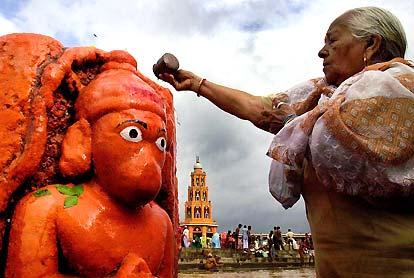
Rajendra Pillai, a Indian Christian
writer explains how to do it?: Pillai
of Clarksburg, Md., is founder and director of Turning
Point,
an organization dedicated to equipping and inspiring Christian
writers. Portions of this article were adapted from Pillai's new
book, "Reaching
the World in Our Own Backyard."
Most Asian-Indians yearn for
community. Coming from a collectivist society, they have a tough
time adjusting to the American individualistic culture. This
is where Christians can step in, and
the church can become the community they are seeking.
One thing that turns off many Asian-Indians is when Christians
in this country just share the Gospel but are not interested in
them in any other way. So if they say "no" to the
Gospel, the same Christian friends and acquaintances disappear
from their lives. Christian Asian-Indians who used to be Hindus
say the most convincing argument for following Christ came
through the love Christians showed toward them.
(source: Outgoing,
yet careful witness can reach Asian-Indians in U.S. -
Baptist News).
Top
of Page
Time
for some soul-searching - By Balbir Punj
Delhi Police, acting upon a
court's intervention, recorded a victim's statement in an FIR
registered five years ago against the Principal of St Martin's
School. The latter was accused of molesting a kindergarten
student. The case was registered in August 1998 by the mother of
the victim, who was too young to record her statement. The
victim now studies in a different school and has identified the
68-year old accused as the perpetrator in camera before a
magistrate.
When
Nagesh Kuknoor's film, Rockford
(1999)-revolving round life in a boarding school-showed young
priests indulging in the heinous practice, it wasn't merely out
of malice. It is important to observe here that the accused
sought permission of the court to call the Archbishop of Delhi
to appear in his defence and it was granted. Fr Melvin D'Souza
was arrested last October for sodomising residents of St Martin
School, Bhawani Kheda village, Nasirabad (Rajasthan).
Fears
have arisen about whether or not the Church poses a threat to
civil society in India, even though the Christian population
stands at a meagre 2.32 percent.
 Many
believe the Church is no longer an institution where one can
feel nearer to divinity. In sharp contrast to Jesus Christ who
lived and died in poverty, the Church is fabulously opulent. Its
business of 'harvesting souls' is run
like a giant multinational corporation. Assumptions that
Christian religious expansion was over with the end of colonial
rule are naive and misplaced. It is true that, for
over 20 centuries, Christians have announced 1,500 global plans
to evangelise the world. Most failed, while 250 plans focussed
on the year 2000 fell massively short of the stated goals. But
from three million in AD 1500, evangelists have grown to 648
million worldwide, 54 per cent being non-Whites. Many
believe the Church is no longer an institution where one can
feel nearer to divinity. In sharp contrast to Jesus Christ who
lived and died in poverty, the Church is fabulously opulent. Its
business of 'harvesting souls' is run
like a giant multinational corporation. Assumptions that
Christian religious expansion was over with the end of colonial
rule are naive and misplaced. It is true that, for
over 20 centuries, Christians have announced 1,500 global plans
to evangelise the world. Most failed, while 250 plans focussed
on the year 2000 fell massively short of the stated goals. But
from three million in AD 1500, evangelists have grown to 648
million worldwide, 54 per cent being non-Whites.
As
Christianity loses its numerical base and popularity in the
West, its survival as an industry is dependent on overseas
proselytisation.
The
Pope was quite matter of fact in his November 1999 speech in New
Delhi where he called for evangelisation in Asia in the 3rd
millennium AD, on the lines of Europe in the 1st and America in
the 2nd millennium.
Another grey
zone of Church activities in India warranting an immediate
full-scale probe are scandals involving its huge estate. Land
donated to religious bodies is legally public property and
cannot be sold or given on lease to a private party. But there
are so many cases sub-judice in different courts of India
involving rampant violation. An increasing number of allegations
hint that a section of Church functionaries in India is sinking
into the morass of avarice, sleaze and luxury in a manner that
is a trenchant betrayal of their congregation.
(source: Time
for some soul-searching - By Balbir Punj - dailypioneer.com
- August 29 2003 - For
more on refer to chapter on Politics
of Conversion).
Top
of Page
Motorola to
make India its research hub
US
telecoms group Motorola is to hire more people in India to make
it a research and technology hub, a report said
“I
see a saving of a billion dollars each through engineering
effectiveness, procurement and the very cost of poor quality. I
want to achieve these goals by 2005,” said Zafirovski. “I am
vigorously driving this and I am sure a part of this can be
outsourced from India. Research and development is obviously
headed here.”
“India is a crouching tiger. In
1999, it had a wireless subscriber base of a million people.
From what I hear it added over a million subscribers in July
(alone).” “India’s phenomenal
growth makes it the most exciting place to be. We are
planning to significantly increase our presence here,”
Zafirovski said. Warrier, a chemical engineer from the Indian
Institute of Technology in Delhi, told the same conference that
Motorola’s research centres in Delhi and Gurgaon were coming
out with products not only for India but the global market. “Motorola’s
Indian labs are designing sophisticated chips used in our GSM
mobile technology. We view
India as a source for creating technology for the world,” said
Warrier.
(source:
Motorola
to make India its research hub
- Dailytimes.co.pk).
Top
of Page
In India, a
Muslim's passion to protect temples
 Mohammad
Yeasin Pathan has paid a high price for his devotion to history.
Muslims have shunned him, Hindus have punched him and anonymous
callers have threatened to kill him. But none of this has dimmed
the Muslim school clerk's determination to work to preserve a
collection of 18th-century temples in eastern India. Mohammad
Yeasin Pathan has paid a high price for his devotion to history.
Muslims have shunned him, Hindus have punched him and anonymous
callers have threatened to kill him. But none of this has dimmed
the Muslim school clerk's determination to work to preserve a
collection of 18th-century temples in eastern India.
"I
passionately respect history. Everyone should, and it does not
matter whether one is a Hindu or a Muslim," said Pathan,
speaking amid the terracotta-and-brick temples in the
Hindu-dominated village of Pathra west of Calcutta. Pathan's
volunteer efforts over the last two decades to preserve the 34
temples at Pathra. "Some Muslims still call me kafir."
At
Pathra, dotted with temples
mostly dedicated to Shiva and Vishnu,
most Hindus welcome Pathan.
Due to the committee's efforts, the government-run
Archaeological Survey of India (ASI) has agreed to consider
declaring Pathra's temples -- built by feudal landlords between
250 and 300 years ago -- as monuments of national importance and
taking over their upkeep. The
ASI has already restored five temples, filling in cracks and
putting in bricks in gaps created by stolen ones. But a number
are covered with vegetation, with figurines of Hindu gods and
goddesses crumbling on their tan-coloured facades. "Pathan's
efforts in protecting the temples are all the more commendable
as he is a Muslim," said Bimal Bandopadhyay, a senior ASI
archaeologist. For Pathan, history is also about learning.
"It is great to learn from history. You can learn from its glory
and
its mistakes. One lesson is the need to live in peace."
(source: In
India, a Muslim's passion to protect temples
- yahoonews.com).
Top
of Page
Reflections on
life East and West
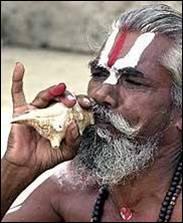 "You live in time; we live
in space. You're always on the move; we're always at rest.
Religion is our first love; we revel in metaphysics. Science is
your passion; you delight in physics. You believe in freedom of
speech; you strive for articulation. We believe in freedom of
silence; we lapse into meditation. Self-assertiveness is the key
to your success; self-abnegation is the secret of our survival.
You're urged every day to want more and more; we're taught from
the cradle to want less and less. Joie de vivre is your ideal;
conquest of desire is our goal. In the sunset years of life, you
retire to enjoy the fruits of your labor; we renounce the world
and prepare ourselves for the hereafter. "You live in time; we live
in space. You're always on the move; we're always at rest.
Religion is our first love; we revel in metaphysics. Science is
your passion; you delight in physics. You believe in freedom of
speech; you strive for articulation. We believe in freedom of
silence; we lapse into meditation. Self-assertiveness is the key
to your success; self-abnegation is the secret of our survival.
You're urged every day to want more and more; we're taught from
the cradle to want less and less. Joie de vivre is your ideal;
conquest of desire is our goal. In the sunset years of life, you
retire to enjoy the fruits of your labor; we renounce the world
and prepare ourselves for the hereafter.
(source - Reflections
on life East and West - By Hari N Dam. Ensign
Magazine 1971).
Top
of Page
Ram
katha in Rainforests a hit with Brazilians - By Saurabh
Shukla
India
and Brazil may have more in common than the story of the
historical error made by Portuguese explorer Pedros Alvares
Cabral, who sailed from Lisbon in 1500 for India but landed in
Brazil.
Now
the two countries, on board the IBSA tri-lateral initiative, may
discover a 'Shri
Ram'
connection in their ties. Amazon rain forest in Brazil was the
venue recently of a Ram
Katha by Sant Murari Bapu
that drew followers from all over the globe including Brazilians
who danced to the tune of Jai Shri Ram, rather than Samba.
The
famous Amazon resort, Aryau Towers, which has a hotel with
tree-top rooms, even turned vegetarian for 10 days and welcomed
the Ram
bhaktas with Sri Ram T-shirts, with even the hotel staff turned
out in saffron.
It
is no surprise then that the Ministry of External Affairs has
promptly planned a Festival of India in Brazil. Ram Katha may be
on the menu.
(source: Ram
katha in Rainforests a hit with Brazilians - By Saurabh
Shukla - hindustantimes.com).
Top
of Page
A
Western View of Krishna - By George W Russell
I
paused beside the cabin door and saw the King of Kings at play,
Tumbled upon the grass I spied the little heavenly runaway.
The mother laughed upon the child made gay by its ecstatic morn,
And yet the sages spake of It as of the Ancient and Unborn.
I heard the passion breathed amid the honeysuckle scented glade,
And saw the
King pass lightly from the beauty that he had betrayed.
I saw him pass from love to love; and yet the pure allowed His
claim To be the purest of the pure, thrice holy, stainless,
without blame...
And yet He is the Light of Lights whose blossoming is Paradise,
That Beauty of the King which dawns upon the seers’ enraptured
eyes.
I saw the King of Kings again, a miser with a heart grown cold,
And yet He is the Prodigal, the Spendthrift of the Heavenly
Gold, The largesse of whose glory crowns the blazing brows of
cherubim,
And sun and moon and stars and flowers are jewels scattered
forth by Him.
I saw the King of Kings descend the narrow doorway to the dust
With all his fires of morning still, the beauty, bravery, and
lust.
And yet He is the life within the Ever-living Living Ones, The
ancient with eternal youth, the cradle of the infant suns,
The fiery fountain of the stars, and He the golden urn where all
The glittering spray of planets in their myriad beauty fall.
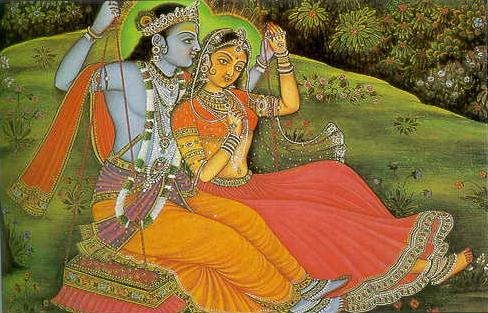
George
W Russell also known A E Russell (1867 - 1935) the Irish
poet, essayist, painter, Nationalist leader, mystic, and
economist; a leader in movement for cooperation among Irish
farmers; editor The Irish Statesman 1923-30.
(source:
A
Western View of Krishna - By George W Russell).
For more on Russell refer to Quotes41_60).
Top
of Page
Religion
in villages of India
Each village
had its own priest. Religion was regarded as an essential part
of social life and there was not a community that did not have a
temple dedicated to God. The priest played an important part in
the social life of the community as did the teacher. Both were
almost synonymous. The village had its bard and poet, who sang
to the people religious and sacred lore of the land. The
national literature of India was much appreciated by the people.
Describing this phase of the home life Professor
Gilbert Slater remarks:
“In every
peasant home a member of the family reads the stories from the
Puranas to other inmates in the vernacular. All the people
listened with rapt attention and sometimes engaged in a lively
discussion. The chief member of the house was expected to know
by heart some of the sacred lore which he recited every morning,
and evening and during the leisure hours of noon. Even the
illiterate peasants of India in a village had something of the
philosophy of life, as given in Hindu culture, transmitted to
him through the agency of the family.”
(source: India:
A synthesis of cultures – by Kewal Motwani p.
160-161).
Top
of Page
Five
Ways to Fight Bad Historians - By
Dnana Raman
 How Can I fight Historians? I Am
Not a History Major… How Can I fight Historians? I Am
Not a History Major…
So how does an engineer, a
computer programmer, a writer, or whoever-else get involved in
the study of history? Isn’t this a “specialization” that
requires years of vigorous study? To be sure, there are
sub-areas like archeology and linguistics which require a good
deal of specialization and study. But most “historians” are
people like you. The only difference being they read
translations of Hindu books, write a few irrelevant papers,
publish some mediocre books and adopt titles that read
“Professor of Sanskrit Studies” or “Professor of Indology.”
I know some of you are probably
thinking: “Wait a minute, they can’t be like me.” You’re
right – they are people who could never get into an Indian
engineering school or successfully establish themselves in any
competitive career. Their IQ ranges between that of a dyslectic
ring-worm and a malformed dung-beetle. I’ll admit I misspoke;
they aren’t exactly people like you and me.....
(source: Five
Ways to Fight Bad Historians - By
Dnana Raman - swaveda.com - A Forum for Hindu Studies). For more refer to Call
For An Intellectual Kshatriya
- by
Rajesh Tembarai Krishnamachari.
***
NCERT
brings out book to counter ‘Ifran Habib & Co’
If
the Indian History Congress (IHC) produced a tome Index of
Errors on the new NCERT textbooks, the NCERT has come up with a
counter publication equally huge (246 pages) on Fallacies in the
IHC Report rubbishing the Errors as ‘‘nitpicking
by old school masters’’.
Authored
by Makhan Lal, Meenakshi Jain and Hari Om — the NCERT’s new
historians of ancient, medieval, modern and contemporary world
— the book released by HRD Minister Murli Manohar Joshi rebuts
the history of ‘‘Habib & Co’’.
Director
R.S. Rajput writes in the introduction: ‘‘There is no need
to be apologetic for foreign invaders like Mahmud of Ghazni or
Alauddin Khalji or Babur...The specious plea that Muslim
sentiments will be hurt if some foreign invaders are shown in
their true colours, actually constitutes an insult to our Muslim
brothers and sisters...,’’ he is quite straight forward.
80 per cent of the errors pointed out by Irfan Habib, Suvira
Jaiswal and Aditya Mukherjee in the IHC report can be traced
back to Romila Thapar and R.S. Sharma. The errors
appear in the extracts/quotes the new authors used from the old
NCERT texts of Thapar and Sharma.
Similarly, Meenakshi Jain’s expresses
surprise that Habib has objected as the points being debated
were picked up from his own books/articles and that of his
Leftist friends.
Top
of Page
Spiritually
hooked on to India
Dennis
Roman was spiritually hooked on to India long before i-flex
Solutions’ senior management made a secular pitch to him —
to join them as chief marketing officer for the Americas and
Japan, and establish the i-flex brand there.
Roman’s
15-year Indian connection goes back to his guru Gurumayi
Chidvilasananda. Introduced to her in 1987 by his
wife, who works in the fashion industry in New York, he was sold
for life. The Romans are now regulars to Gurumayi’s Ganeshpuri
ashram near Mumbai — their daughter’s spent a year there. “I
follow Indian traditions in my house,” says Roman, adding
it’s got “a meditation room with all the gods and
goddesses.”
(source: Spiritually
hooked on to India - economictimes.indiatimes.com).
Top
of Page
Frescos
of Hindu gods whitewashed
 Wall
paintings of Hindu gods including Lord Rama and Lord Krishna,
which were unique specimens of Sikh school of art, have
disappeared from the upper storey of Sri Darbar Sahib here
founded by fifth Sikh Guru, Guru Arjan Dev in 1597 A.D.
It is learnt that the frescos of Hindu gods were erased during
the ‘kar seva’ being carried out by Baba Jagtar Singh at the
behest of the Shiromani Gurdwara Prabandhak Committee.
Wall
paintings of Hindu gods including Lord Rama and Lord Krishna,
which were unique specimens of Sikh school of art, have
disappeared from the upper storey of Sri Darbar Sahib here
founded by fifth Sikh Guru, Guru Arjan Dev in 1597 A.D.
It is learnt that the frescos of Hindu gods were erased during
the ‘kar seva’ being carried out by Baba Jagtar Singh at the
behest of the Shiromani Gurdwara Prabandhak Committee.
The
frescos were unique specimens of Sikh school of art, completed
in the year1824, during the regime of Maharaja
Ranjit Singh. According to Sikh history, Maharaja
Ranjit Singh got the gold-plating and interior decoration of the
Darbar Sahib completed by taking personal interest.
(source:
Frescos
of Hindu gods whitewashed
- tribuneindia.com).
Top
of Page
Israeli
guns to guard Tirupati deity
Tirupati:
Security at the Tirumala temple here is all set to go hi-tech.
Plans are afoot to import lightweight pistols from Israel to
guard the Lord. The weapons would be similar to the ones being
used by the special protection group (SPG), which provides
security to VVIPs.
Negotiations
are still under way as each pistol is priced around $1,500.
Chief vigilance and security officer E Damodar refused to reveal
the number of units likely to be imported. The
move is part of the increased security measures being enforced
in the temple premises. Godrej
officials have assessed the feasibility of providing bulletproof
glass enclosures in front of the queues leading to the temple
and at the mahadwaram. Special bulletproof booths have also been
planned.
The
Tirumala Tirupati Devasthanams (TTD) has already inducted a bomb
disposal unit and special scanners. It
has also set up an exclusive communication network for officials
on duty, at a cost of Rs 18 lakh.
(source:
Israeli
guns to guard Tirupati deity - timesofindia.com).
Top
of Page
NCERT
scoffs at historians’ against textbook errors
The
NCERT has dismissed eminent historians' allegations that its new
history text books are "saffronised". Adopting a
combative stance, the HRD Ministry body described the Indian
History Congress (IHC)'s recently published critique as biased.
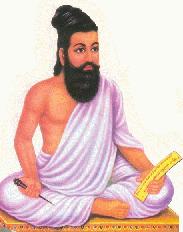 JS
Rajput, the NCERT director, said on Wednesday that the IHC's
Index of Errors is "the
work of scholars with insufficient and coloured knowledge whose
only purpose is to reduce young Indians' respect for their
glorious past. They want us to forget that there was a time when
we Indians were world leaders in science, medicine and
astronomy. JS
Rajput, the NCERT director, said on Wednesday that the IHC's
Index of Errors is "the
work of scholars with insufficient and coloured knowledge whose
only purpose is to reduce young Indians' respect for their
glorious past. They want us to forget that there was a time when
we Indians were world leaders in science, medicine and
astronomy.
The
IHC had blasted the new NCERT texts, which replaced those
authored by the likes of Marxist
historians, Romila
Thapar, Satish Chandra and Irfan Habib.
The Index of Errors highlighted factual mistakes, which
allegedly proved that NCERT was implementing the Sangh Parivar's
agenda of spreading jingoism and communal hatred through
falsification of history.
Ifran
Habib describes as "wooly headed fantasy" the NCERT
text's claim that ancient Indians knew the sphericity of the
earth or had advance knowledge of Pythagoras's theorem.
Rajput
defended the lines by pointing out that Dick
Teresi,
the internationally reputed scholar, has written the same things
in Lost
Discoveries: The Ancient Roots of Modern Science,
a book published in the United States last year. .
Mandsor
inscription found in south India dated 436 AD mentions silk
workers' guilds. Manuscript from India found near Yarkend,
Central Asia, dated 5th Century AD.
(source: NCERT
scoffs at historians’ against textbook errors
- hindustantimes.com). Watch
History
of Ayodhya - videogoogle.com.
***
Pythagoras's
theorem discovered in India in 800 BC
 Pythagoras's
theorem discovered in India in 800 BC according to renowned
historian Dick
Teresi. author and coauthor of several books about
science and technology, including The
God Particle. He is cofounder of Omni
magazine and has written for Discover, The New York Times
Magazine, and The Atlantic Monthly. Pythagoras's
theorem discovered in India in 800 BC according to renowned
historian Dick
Teresi. author and coauthor of several books about
science and technology, including The
God Particle. He is cofounder of Omni
magazine and has written for Discover, The New York Times
Magazine, and The Atlantic Monthly.
"Two
thousand years before Pythagoras, philosophers
in northern India had understood that gravitation held the solar
system together, and that therefore the sun, the most massive
object, had to be at its center."
"Our
Western mathematical heritage and pride are critically dependent
on the triumphs of ancient Greece. These accomplishments have
been so greatly exaggerated that it often becomes
difficult to sort out how much of modern math is derived from
Greece and how much from...the Indians and so on.
"Our modern numerals 0
through 9 were developed in India. Mathematics existed long
before the Greeks constructed their first right angle. On the
other hand George Cheverghese Joseph
(author of The
Crest of the Peacock: Non-European Roots of Mathematics)
points out that the early Indian
mathematics contained in the Sulbasutras (The Rules of the Cord)
contain their own version of the Pythagorean theorem as well as
procedure for obtaining the square root of 2 correct to five
decimal places. The Sulbasutras reveal a rich geometric
knowledge that preceded the Greeks."
(source:
Lost
Discoveries: The Ancient Roots of Modern Science - By Dick
Teresi p. 32 ).
Soviet historians, K.
Antonova, G. Bongard-Levin, and G. Kotovsky, authors
of A
History of India, Moscow, Volume I and II 1973,
have spoken highly of scientists of ancient India and their high
originality:
"In the ancient period and
in the early Middle Ages lived the outstanding mathematicians Aryabhatta
(5-6th centuries), Varahamihira
(6th century) and Brahmagupta (late
6th and early 7th centuries), whose discoveries anticipated many
scientific achievements of modern times. Aryabhata knew that pi
equaled 3.1416. The theorem known to us as Pythagoras' theorem
was also known at that time. Aryabhata proposed an original
solution in whole numbers to the linear equations with two
unknowns that closely resembles modern solutions.
"The ancient Indians evolved
a system for calculation using zero, which was later taken over
by the Arabs (the so-called Arabic numerals) and alter from them
by other peoples. The Aryabhatta school was also familiar with
sine and cosine.
"Scholars
of the Gupta period were already acquainted with the movement of
the heavenly bodies, the reasons for eclipses of the Sun and the
Moon. Aryabhatta put forward a brilliant thesis with regard to
the Earth's rotation on its axis."
(source: A
History of India - By K.
Antonova, G. Bongard-Levin, and G. Kotovsky Moscow, Volume I and II
1973).
For
more refer to chapter on Greater
India: Suvarnabhumi and
Sacred
Angkor
Sir
William Jones
firm
belief in the Vedas is challenging and at the same time
illuminating:
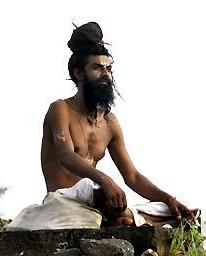 "The six
philosophical schools, whose principles are explained in the
Darsana Sastra, comprise all the metaphysics of the old Academy,
the Stoa, the Lyceum; nor is it possible to read the Vedanta, or
the many fine compositions in illustration of it, without
believing that Pythagoras and Plato derived their sublime
theories from the same fountain with the Sages of India." "We
are told by the Greek writers that the Indians were the wisest
of nations, and in moral wisdom, they were certainly
eminent." "The six
philosophical schools, whose principles are explained in the
Darsana Sastra, comprise all the metaphysics of the old Academy,
the Stoa, the Lyceum; nor is it possible to read the Vedanta, or
the many fine compositions in illustration of it, without
believing that Pythagoras and Plato derived their sublime
theories from the same fountain with the Sages of India." "We
are told by the Greek writers that the Indians were the wisest
of nations, and in moral wisdom, they were certainly
eminent."
Professor
Edward Washburn Hopkins (1857-1932) Indologist, Chair
of Sanskrit Studies of Yale, says:
"Plato is full of Sankhyan
thought, worked out by him, but taken from Pythagoras. Before
the sixth century B.C. all the religious-philosophical idea of
Pythagoras are current in India (L. Schroeder, Pythagoras). If
there were but one or two of these cases, they might be set
aside as accidental coincidences, but such coincidences are too
numerous to be the result of change. "
Sir William
Wilson Hunter
wrote: "The Hindus attained a very high proficiency in
arithmetic and algebra independently of any foreign
influence."
The Surya
Siddhanta is based on a system of trigonometry.
Professor Wallace says: "In fact it is founded on a
geometrical theorem, which was not known to the geometricians of
Europe before the time of Vieta, about two hundred years ago.
And it employs the sine of arcs, a thing unknown to the
Greeks." The 47th proposition of Book I of Euclid, which is
ascribed to Pythagoras was known long ago to the Hindus and must
have been learnt from them by Pythagoras.
(source: Indian
Culture and the Modern Age - By Dewan Bahadur K. S. Ramaswami
Sastri Annamalai University. 1956 p. 67).
Professor
H. G. Rawlinson writes: " It is more likely that
Pythagoras was influenced by India than by Egypt. Almost all the
theories, religions, philosophical and mathematical taught by
the Pythagoreans, were known in India in the sixth century B.C.,
and the Pythagoreans, like the Jains and the Buddhists,
refrained from the destruction of life and eating meat and
regarded certain vegetables such as beans as taboo"
"It seems that the so-called Pythagorean theorem of the
quadrature of the hypotenuse was already known to the Indians in
the older Vedic times, and thus before Pythagoras
(source: Legacy
of India - Edited by G. T. Garrett 1937, p. 5).
Professor
Maurice Winternitz is of the same opinion: "As
regards Pythagoras, it seems to me very probable that he became
acquainted with Indian doctrines in Persia." (Visvabharati
Quarterly Feb. 1937, p. 8).
Ludwig
von Schröder German
philosopher, author of the book Pythagoras
und die Inder (Pythagoras and the Indians), published
in 1884, he argued that Pythagoras had been influenced by the
Samkhya school of thought, the most prominent branch of the
Indic philosophy next to Vedanta.
(source: Eminent
Orientalists: Indian European American - Asian
Educational Services. p.11).(source:
In
Search of The Cradle of Civilization: : New Light on Ancient
India - By Georg Feuerstein, Subhash Kak & David Frawley
p. 252).
Top
of Page
Vedic Arabs
and Vedic Druids?
Arabia was not
free from the influence of the followers of Vedic Dharma (the
Aryans) – the people who migrated after Mahabharata war nearly
to all corners of the world. Some of them reached the tract where they found speeding
horses of good breed. They named it Arvansthan
meaning the land and abode of horses because arvan
is the Sanskrit word for ‘horse’ of good quality.
Gradually Arvansthan changed to Arvasthan then to Arbansthan and
later to Arabstan. In due course and over a number of years it
got shortened to Arab. When the English became powerful in the
world they anglicized it to Arabia.
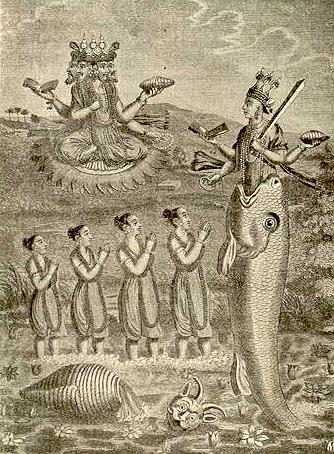
***
Another section
of the migrants who happened to be more learned in the Vedic
scriptures reached the Isles of Britain (Brittany) and came to
be known as Druids which again is a distortion of the Sanskrit
word Dravid which is derived from two Sanskrit roots dra meaning
a ‘seer’ and vid meaning the learned and knowing. The
Dravida of yore were highly cultivated people well versed in all
branches of Vedic literature, learning and practices. The Druids
of England practice even to this day many a Vedic ritual. “The
Asiatic origin of the Druids has long been an acknowledged point
in the world of antiquities.
Reuben
Burrow, author 'A Proof that
the Hindoos had the Binomial Theorem', Asiatic
Researches vol. ii: 388-395; First published 1790, the great
practical astronomer of India, was the first person, who after a
strict examination and comparison of their mythological
superstitions and their periods directly affirmed them to be a
race of emigrant Indian philosophers. Again: “These priests
(the Druids), Brahmins of India spread themselves widely through
the northern regions of Asia even to Siberia itself, and
gradually mingling with the great body of Celtic tribes (Kolotaya
people to the south of Kashmir) pushed their journey to the
extremity of Europe and finally established the Druid that is
the Brahmin system of superstition in ancient Britain – This I
contend was the first Oriental colony settled in these (British)
islands.”
(source: The
Hindu? - By Krishna Vallabh Paliwal and Brahm Datt Bharti
p. 46 - 47).
Thomas
Maurice (1754-1824) who was inspired to address in
one of the volumes of his 'Indian Antiquities' the issue it
raised of the relationship between Druids and Brahmins.
Introducing 'A Dissertation on the Indian Origin of the Druids
and on the Striking Affinity which the Religious Rites and
Ceremonies, Anciently Practiced in the British Islands, bore to
those of the Brahmins', Thomas Maurice referred to Burrow's
earlier work as having established the fact that the genesis of
Druidry was found in Asia (Maurice 1812: iv-v).
Top
of Page
On
Colonial Experience and the Indian Renaissance: A Prolegomenon
to a Project - By S N Balagangadhara
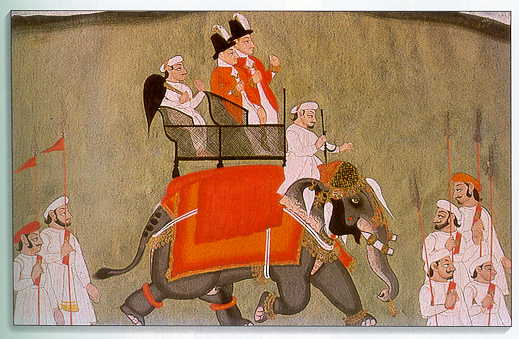
The British criticized the
Indian 'religions', the Indian 'caste system', the Indian
education system, practices like 'sati' and 'untouchability',
and so on and so forth.
***
One of the
striking things about the British colonial rule is its success
in developing certain ways of talking about the Indian culture
and society. The British criticized the
Indian 'religions', the Indian 'caste system', the Indian
education system, practices like 'sati' and 'untouchability',
and so on and so forth. They redrew the outlines of
Indian intellectual history as indigenous responses to some of
the ills they saw in the Indian society and culture: for
example, 'Buddhism', as it emerged out of their reconstruction,
was a revolt against 'Brahmanism' and 'the caste system'
(source: On
Colonial Experience and the Indian Renaissance: A Prolegomenon
to a Project - By S N Balagangadhara
Colonialism
is not merely a process of occupying lands and extracting
revenues. It is not a question of encouraging us to ape the
western countries in trying to be like them. It is not even
about colonizing the imaginations of a people by making them
dream that they too will become 'modern', developed and
sophisticated. It goes deeper than any of these. It
is about denying the colonized peoples and cultures their own
experiences; of making them aliens to themselves; of actively
preventing any description of their own experiences except in
terms defined by the colonizers."
(source:
yahoo.groups.com).
For more on the British refer to the chapter on European
Imperialism).
Top
of Page
How the West
has distorted Indian history
He is a Frenchman on a
mission: to correct distortions in Indian history.
“The Aryan invasion may never really have happened,” says
Francois Gautier. He has lived in India for 34 years
and studied the country from a journalist’s viewpoint as
political correspondent for international newspapers like Le
Figaro and Le Journal de Geneve. Bangalore Times asked Gautier,
who is visiting Bangalore for his show on Kashmir, to give
incidents in history that are otherwise perceived to be true.
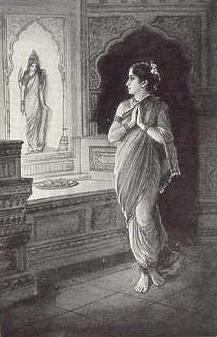
Laxshmi
puja
Indian history has been projected from a Western
viewpoint, Francois points out. “When the British still lived
in caves, Indians had a civilisation. But the British wanted to
show that civilisation as we know it came from the West. For
instance, the Mutiny was barbaric, we’re told, but actually it
was simply a spontaneous uprising. What was barbaric was the way
the British took revenge after it was over,” he says. “Max
Mueller dated the Vedas at 1500 BC, whereas they’re much
older. If this theory is wrong, history should be rewritten,”
he says. British callousness
is also evident in the non-documentation in Indian history of
the Great Famine, when millions of Indians died of starvation
between 1820 and 1920, he says. “The British broke
the Indian systems in place at the time. The agricultural
system, the bartering system in the villages were destroyed to
impose their own system of taxes. They impoverished the soil and
broke up the land, so famine naturally followed.”
According to Gautier, “The
Ramayana and Mahabharata, epics written when there were no
religious divides, show the greatness of Indian literature.
Kalidasa’s works are extraordinary even today. Indian children
should study their own literature, not Milton and
Shakespeare.”
Indian expertise in areas like computer science,
according to Gautier, has a historical basis. “The Indians
invented zero, and had the most elaborate astronomical system,
but this isn’t reflected in Indian history books. It’s time
Indians became proud of their own culture.” And how did
Gautier come to the conclusion that Indian history is not what
we were taught to believe? “I realised that what I read
didn’t correspond with reality. It was an image fashioned by
British historians to suit their own purposes.”
(source: How
the West has distorted Indian history - By Ruma Singh -
timesofindia.com).
For
more refer to chapter on Greater
India: Suvarnabhumi and
Sacred
Angkor
Top
of Page
Reverse colonization?
How are the Brits surviving
India? By getting the hell out of London
Because as
immigrants are coming in, substantial numbers of white British
middle-class people are moving out of Britain. One way of
surviving us is to leave us if we don’t leave them.
Last
year about a quarter of a million people moved into Britain;
about as many moved out. A good many arrivals were from India.
Those moving out are white British middle-class people, to
Spain, to the south of France, to Canada. Take that incoming
quarter-million with the outgoing quarter-million, place them
against a population more or less constant, and you see why a
senior academic produced a report saying white British people
will become a minority by the end of this century. The face of
Britain is changing fast, and the face looks more Indian all the
time.
There were more white people in London at the end of the Second
World War, when the whole population was much less, than there
are today. White Brits are leaving London for an immigrant-free
countryside, and for those quaint little towns that are still
English. The census shows 1.2 million Indians, some half million
in London.
To cap this, the Indian, the
Indian with the British passport that is, will cheer till he’s
hoarse if India can beat England at cricket. The usual English
approach with these signs is to let be. That approach is now
straining at the edges. More and more signs of irritation are
beginning to get past the stiff upper
lip; the particularly high pitch of the media
campaign against once high-fliers like Laxmi Mittal, the
Hindujas, even Keith Vaz. The slow abandonment of English
civility in the face of the foreigner. Now not just the loss of
jobs to Indians in Britain, but loss of more jobs through
outsourcing to India.
Indian
success with the curry could be indulged. Indian success in
software is proving harder to accept. It is flattering to be
this kind of nuisance, but the British are far more accustomed
to stealing into other markets than have others steal into
theirs. And it does not help that India is doing a
far better job surviving the IT crash than Britain. Indian
professionals in Britain are seen to work for smaller wages than
the British have come to expect; and in India for even less.
This is probably the current top of the irritants.
(source:
Ol'
Blighty, My Pind - outlookindia.com).
Top
of Page
A BBC
rendition of The Ballad of East and West
Humphrey
Hawksely, reporting India's IT revolution on BCC 2's Newsnight
last week, decided to use the occasion to educate us on the
country's social and economic history. After a brief concession
attesting to the quality and prowess of India's technological
might, he was at pains to establish for the viewers a
non-existent relation between India's resurgent IT growth and
the nature of its democracy and acknowledged capacity for
procreation. For his laboured denouement, Hawksley visited a
photogenic slum and proclaimed, standing smugly clad in a clean
shirt and perfectly creased trousers, with naked children
prancing in the frame, that 'it's vast, it's appalling, and it's
pretty unforgivable'.
This
conceptual glue that once contained the Raj also bound the
fabric of the BBC, and other elements of the establishment. From
such a perspective arose ideas that characterised, and often
justified, the notion of empire. The colonisers constructed the
history of the colonised from their vantage point, 'seeing them
as subjects whose fate is to be decided not by them but by what
distant administrators think is best for them'.
Today
the sun has forever set on the British Empire. However, despite
the wholesale disintegration of the colonial apparatus, the
vestiges of a colonial mindset persist in the subconscious
obscuring any understanding of the clock of history coming full
circle.
If the imperial subjugation of India in the 18th century fueled
the growth of an industrial Manchester, it is now the turn of a
decadent Manchester to give way to a blustering Mumbai. Literature
does not record a better example of poetic justice and it is in
the poetry of the evolving history that the final redemption of
the gulf that divides the colonised and the coloniser
lies:
India's IT revolution is the bridge that spawns the divide
separating the two. To see it any differently, Mr Hawksley, is
to myopically hark back to the days of colonial rule that remain
confined and consigned to the pages of British history.
But,
of course, the western view of the Orient contains no such
provisions! India
continues to pose a further problem, for not only does it break
the ranks of subordination, it flaunts the audacity to poke fun
at its former masters.
A
more economical Indian workforce is winning jobs from all over
the western world adding to growing unemployment in economies
that are struggling under the specter of war and a prolonged
recession.
(source:
A
BBC rendition of The Ballad of East and West -
hindustantimes.com).
Top
of Page
Bajirao
Peshwa: 'More to forgotten hero than Mastani saga'
There
are gaping holes in history where his name should have been. Bajirao,
one of the greatest military minds of the Maratha Peshwas may
now have ignited Bollywood's imagination, but the very city
which this great Maratha gave an identity to, seems to be
forgetting its hero.
 According
to K V Peshwa, the ninth generation direct descendant of the
greatest of all Peshwas, Bajirao's legend has been ignored for
too long. Monday marked the 303rd birth anniversary of the
Brahmin-warrior and apart from the routine Government functions
and the traditional garlanding of his statue, there was little
else to remind the people of their celebrated heritage/ According
to K V Peshwa, the ninth generation direct descendant of the
greatest of all Peshwas, Bajirao's legend has been ignored for
too long. Monday marked the 303rd birth anniversary of the
Brahmin-warrior and apart from the routine Government functions
and the traditional garlanding of his statue, there was little
else to remind the people of their celebrated heritage/
Not
content to wait and watch are a group of concerned Pune
residents, including the only two descendants of Bajirao Peshwa,
who have come together to form the Marathi Rajya Smriti
Pratishthan trust, which is actively involved in seeking due
recognition for the warrior king. The
group has now written to director Sanjay Leela Bhansali, whose
mega-project Bajirao Mastani, has sent the Bollywood beehive
buzzing even before the script is finalised, asking him to keep
his facts on the Peshwa, correct.
"There
are only anecdotes regarding the legend of the romance between
Bajirao and Mastani. We know the film will be grand and opulent,
but there is a great likelihood of facts getting distorted in
order to make it glitzy for the Box-Office," said a member
of the group." There is more to the Bajirao saga than the
heady romance with Mastani," say members of this group, and
they wonder if the Box-Office formula factory is listening.
Bajirao's
descendants, along with a small group of concerned citizens, are
now mobilising support to seek the installation
of a statue of Bajirao Peshwa in Parliament.
According
to K V Peshwa, a geologist, now devoting time to the legacy of
his forefather Bajirao, the city of Pune itself has disappointed
him. As it is Bajirao Peshwa finds a
bare mention whenever the history of the Marathas has been told,
and little effort has been made to rectify that, but to add
insult to injury, Bajirao has been neglected by Pune also. "There
should at least be a statue of Bajirao in Parliament. Also,
his residence Shanivarwada must be put on the heritage map of
India," he said.
(source:
Bajirao
Peshwa: 'More to forgotten hero than Mastani saga' -
By Karuna
M John - Daily Pioneer.com August 20 2003).
Top
of Page
Hinduism
is mankind's oldest spiritual declaration
Hinduism
is unique among the world's religions. To begin with, it is
mankind's oldest spiritual declaration, the very fountainhead of
faith on the planet. It is the only religion, to my knowledge,
that is not founded in a single historic event or prophet, but
which itself precedes recorded history.

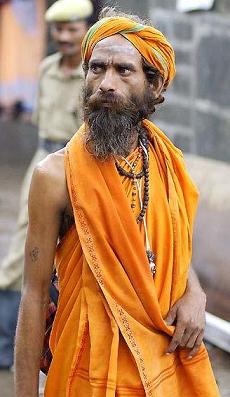
Hinduism
is mankind's oldest spiritual declaration.
***
Hinduism
has been called the "cradle of spirituality" and
"the mother of all religions," partly because it has
influenced virtually every major religion.
This is possible because Hinduism looks compassionately on all
genuine spiritual effort and knows unmistakably that all souls
are evolving toward union with the divine, and all are destined,
without exception, to achieve spiritual enlightenment and
liberation in this or a future life.
Hinduism
is also the world's only religion that allows
scientific experiment with -- and questioning of -- the
existence of God.
Unlike any other religion, it
does not have a traditional dogma.
In fact, the only dogma it has is that it must not have one. It
is the only religion that fosters diversity in a true sense. If
you have a faith, any faith, you are already a Hindu.
In
Hinduism, the
divine can be conceived as a feminine form -- another
uniqueness.
While people of some prominent religions are fighting for the
superiority of their gods through brute force, in a
demonstration of catholicity and respect for diversity, the
Hindu seekers declared nearly 8,000 years before Christ: Ekam
sat, vipra bahuda bedanti (truth is one, sages call it by
various names).
Spoken
in mathematical context, the search for ultimate truth was
started by the Hindus through a method analogous to the solution
of a transcendental equation where unknown cannot express as an
explicit function of the known, requiring a trial-and-error
solution.
Implicit in the approach is the fact that while the solution is
unique, the path to the solution is not. A seeker assumes a
model, focuses on it as a god, and eventually discovers that it
is not God. The seeker then takes the opposite approach,
eliminates what is not God, and eventually transcends to the
ultimate truth. In seeking ultimate truth from both directions,
the Hindus discovered the null, later on called zero.
Hinduism
has a great diversity among its many sects.
That diversity is itself a strength, showing how broad and
encompassing Hinduism is. It does not seek to have all devotees
believe exactly alike. In fact, it has no central authority, no
single organized institution that could ever proclaim or enforce
sameness. There is an immense inner unity, but the real strength
and wisdom of Hinduism is its diversity, its variety.
Each
sect may be said to be a full religion in its own right, with
all the increments of faith, with no necessary part missing.
Therefore, each sect works for the individuals within it
completely, and each tolerates all the other sects. It does not
totally divorce itself from the other sects, denying their
beliefs, but simply separates to stress or expound upon a
limited area of the vast philosophy, apart from all others, to
be understood by the limited faculties of man.
Tapas
K. Das, a chemical and environmental engineer at the Department
of Ecology, is a member of The Olympian's Diversity Panel.
(source: Hinduism
is mankind's oldest spiritual declaration
- By Tapas
K. Das).
For
more refer to chapter on Greater
India: Suvarnabhumi and
Sacred
Angkor
Top
of Page
Kashmir
pashmina may go the Basmati way - Fake
products are being sold as traditional pashminas
 One
of the worst impacts of the 12 years of militancy in the Kashmir
valley has been on the exquisite traditional pashmina shawls.
Chinese machine-made yarn and shawls have swamped the markets,
edging out the hand-made local pashmina. One
of the worst impacts of the 12 years of militancy in the Kashmir
valley has been on the exquisite traditional pashmina shawls.
Chinese machine-made yarn and shawls have swamped the markets,
edging out the hand-made local pashmina.
A
range of fakes from China, Nepal and our own powerlooms in
Punjab are being passed off as pashmina from Kashmir. With
pashmina being produced in bulk on powerlooms, prices have
dropped to an all-time low. The
cost of the pashmina stole or small shawl in London was
initially $200 a piece. Now the adulterated product is being
sold in flea markets of Europe for just $15 to $20.
While some amount of blame can be put on the turmoil in the
valley, the sad fact is that the Indian
pashmjina has no patent.
Neither
the authorities in the valley nor those in Delhi realise the
importance of a patent. So spurious shawls are being marketed
abroad as cashmere or pashmina. Most buyers are not discerning
enough to see the difference in quality and are easily taken in
by the brand names. It
may be too late already to save the Kashmir pashmina. So the
exquisite pashmina, whose history dates back to the days of
Mohenjadaro, (the soft fine fabric draped around the statue of a
woman found at Mohenjadaro was probably pashmina from the
valley) may go the way of Basmati, neem and haldi.
Brands
are protected by copyright laws. There are laws for design
regulation too but no one is enforcing them, says Asif Ali.
However, under the Prime Minister’s recently announced package
for Jammu and Kashmir, the Development Commissioner for
handicrafts at the Centre is trying to bring some order into the
mess created in the pashmina trade.
(source: Kashmir
pashmina may go the Basmati way - By Usha Rai -
tribuneindia.com).
Top
of Page
Tamil
Literature and Sangam writers
Srinivas
Shastri has rightly paid tribute to the Sangam writers:
“the
Sangam writers were concrete, alive with the play of thought and
these poems present a vivid picture of material civilization.
Apart from the intrinsic poetical, they are also an
inexhaustible source book of early social history of the Tamil
land.” Two epical works ‘Silpapadikaram’
and ‘Manimekhlai’ Tamil
literature achieved a new apex. They have been compared with
Ramayana and Mahabharata.
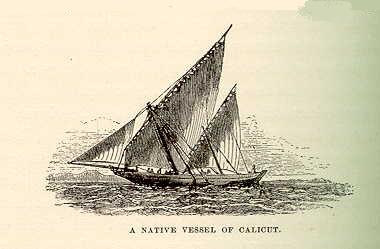 Both the
works abound in tales of foreign voyages and possess the
sublimity of a work of art. Tamil literature received
fresh impetus from the Nayanmars and Alvars who composed highly
devotional songs which echo intense devotion and deep wisdom: Both the
works abound in tales of foreign voyages and possess the
sublimity of a work of art. Tamil literature received
fresh impetus from the Nayanmars and Alvars who composed highly
devotional songs which echo intense devotion and deep wisdom:
“Should
men live on hundred years as the Vedas say,
One half will be wasted in sleep; the fifty remaining
Will be likewise wasted
In childhood, boyhood, sensuality, hunger, disease and old age,
O dweller in Sriranga temple! I desire birth no more. --
Tondardipodi
In
this glorious tradition, Tiruvallur was the most acclaimed poet.
(source:
India Rediscovered - By Dr. Giriraj
Shah p. 46 - 47 Abhinav Publications New Delhi 1975).
Top
of Page
Summer
of discontent in the Western world?
It has been,
literally, a summer of discontent for what we call the
"Western world". High temperatures, disease,
pestilence and, worst of all, power outages; for the
Biblically-inclined, these are the modern version of the four
horses of the Apocalypse, the portents of the coming doomsday.
All the
difficulties we associate with the third world have visited upon
the highly developed first world in a matter of weeks. Europe
got hit by a heat wave that could rival anything in the dry
plains of Bihar and Uttar Pradesh. And, while our annual tally
of deaths in summer run into dozens, over 11,000 people died in
France alone because of the unprecedently high temperatures, a
scandal by any standards. Most of them were old, unable to look
after themselves and their deaths have exposed the poor
condition of hospitals and old-age homes.
Canada,
said to be one of the best places in the world to live in, has
been hit by a triple whammy: First SARS
(Toronto was the only non-Asian city to be quarantined), then
the mad cow disease and, finally, a huge power outage that
crippled an entire province. In New
York, whose chutzpah was shaken by 9/11, the power
failure immediately raised the spectre of another terrorist
attack. But the culprit turned out to be more mundane and closer
to home: Badly maintained and overstrained infrastructure which
had not been updated for decades. Britain,
not to be left behind its continental cousins, had a mini-power
breakdown of its own, and the city of London came to a
standstill for 40 minutes at peak hour.
The
hapless third-worlder can be forgiven for chuckling, even
gloating over the misery of the more advanced nations.
In our own Capital, where power outages are more frequent than
changes of government in Uttar Pradesh, the first reaction was:
Now they'll know how the rest of the world lives. The more
nationalistic among us, who get touchy about Westeners
criticising Indian failures, pointed out that the West must
first gets its own house in order before trying to fix the
developing world. And
certainly, it does seem to be a fair response, given that mass
deaths due to boiling heat, unheard of diseases which take lives
and infrastructural collapse are all part of the third world
experience. It is to escape these very things that people,
migrate to the West; otherwise, why not stay at home, where at
least you have the support of friends and family?
But
this smug and superior attitude needs to be tempered.
True,
a country (France) that lets 11,000 of its old people die just
because the temperature goes up a few degrees or one that issues
"travel advisories" to its citizens to take all manner
of vaccinations before going to disease-ridden Asian nations
while becoming a hotbed of SARS do not have the right to moralize.
(source:
West
side success story - By
Sidharth Bhatia - dailypioneer.com September 2 2003).
Top
of Page
Now they slip
further: 'Om' symbols on socks
 First
it was a toilet seat. Then it was humble slippers. If you
thought that things couldn't any lower, then you are wrong. First
it was a toilet seat. Then it was humble slippers. If you
thought that things couldn't any lower, then you are wrong.
Now a US company has pictured traditional 'Om' symbol
on socks.
Westerners who talk
themselves hoarse about valuing customs and traditions of other
religions, apparently don't really seem to care about Hindus and
their religious symbols. Understandably the socks
issue has outraged the Indian community in the US.
'We are outraged seeing such repetitive insults and
attack on Indian culture,' IndiaCause coordinator Sanjeev
Dahiwadkar said. IndiaCause is an outfit that takes up issues
pertaining to India abroad
Gold Medal Hosiery in New York is the company that has
distributed the offending socks. The label on the socks says the product has been made
in South Korea. They have been designed by New Yorker Linda
Maddocks.
Dahiwadkar said in the recent past there had been at
least three instances where India and Indian culture were
attacked.
Earlier, he said, images of Lord Ganesh and goddess
Kali were offensively used on toilet seats, an article depicted
a muscleman beating up an image of Mahatma Gandhi and Ganesh
images were used on slippers. We have seen the images of the socks. We are trying to
gather the information about the company and the US
distributor,' Dahiwadkar has been quoted as saying.
IndiaCause is planning to send letters to US
distributors and manufacturers about how such products affect
the feeling of Indians in general. The company may withdraw the
offending product. But there is no guarantee that another
company would feature another Hindu symbol in its product,
which, for all we know, may be an undergarment.
(source: IndiaCause
and
Now
they slip further: 'Om' symbols on socks).
Top
of Page
Cher
chants Gayatri mantra at her concerts
 Just
after she swaggers through the thumping disco anthem 'Song for
the Lonely' and right before she makes a dramatic entrance
atop a giant, gaily painted mechanical elephant, chart-topping
diva Cher gets spiritual -to the calming tones of the Gayatri
Mantra. Just
after she swaggers through the thumping disco anthem 'Song for
the Lonely' and right before she makes a dramatic entrance
atop a giant, gaily painted mechanical elephant, chart-topping
diva Cher gets spiritual -to the calming tones of the Gayatri
Mantra.
It
seems the ancient Sanskrit chant is a
favourite of the 57-year-old pop music queen, who
first heard it during a yoga class as performed by the German
new age singer Deva Premal.
"My
favorite CD to do yoga is Deva Premal's The Essence," Cher's
performance of the Gayatri Mantra can also be seen on the
just-released DVD, The Farewell Tour. Cher performs the chant,
as arranged by Deva Premal, during her Living
Proof Farewell Tour.
The
sellout tour, which has entertained an estimated 1.5 million
fans across North America already, hits the Concord Pavilion in
Northern California on Friday, the ARCO Arena in Sacramento
Sept. 6 and other cities.
(source:
Cher
chants Gayatri mantra at her concerts - By Lisa Tsering
- The
Times of India September
5, 2003).
Top
of Page
India en route
for grand highways
Smooth,
pristine roads; traffic flowing at over 100km/h; emergency
medical teams on standby for accidents.
 It
is not an image many would associate with the Indian road
network. But India is changing at last. The country is
witnessing one of the world's largest road building projects,
worth more than $12bn. It
is not an image many would associate with the Indian road
network. But India is changing at last. The country is
witnessing one of the world's largest road building projects,
worth more than $12bn.
With roads up to six lanes wide
covering nearly 14,000 kilometres (8,750 miles), Indian
officials say the country is finally gearing up to take on its
Asian economic rival, China.
In October 1998 Prime Minister
Atal Behari Vajpayee promised the people of India world-class
roads connecting the whole country. An extra rupee on every
litre of petrol or diesel was levied to fund the project. The
scheme, which is regarded as Mr Vajpayee's dream, has also
received the backing of the World Bank and other financial
institutions. Often, such huge projects in India are
ill-conceived. They lack planning, meet bureaucratic hurdles and
invariably result in time and cost overruns. Nearly five years
later, 80% of the first phase of the project has been completed,
say officials. It connects India's four big cities - Calcutta,
Madras, Delhi and Bombay, also known as Mumbai.
Work on the second phase
connecting Srinagar in the north to Kanyakumari in the south and
Silchar in the east to Saurashtra in the west is due to begin
shortly. The deadline for completing the whole project is 2007.
But officials say the speed at which the project is progressing
and the professionalism of those involved could mean it is
completed ahead of schedule.
India's Surface Transport
Minister BC Khanduri told the BBC he has adopted unusual methods
to ensure the project runs to schedule. "I brought the
completion date forward with a view to activate and energise. I
told the contractors to complete the first phase by 2003. I knew
it was difficult," he says. "We started giving
bonuses. For completing the project one month ahead of schedule
we would give 1% bonus and a months' delay could result in a
1.5% penalty."
(source: India
en route for grand highways - BBC news.com).
Top
of Page
Belief in
Rebirth - By S. Gurumurthy
Today's
Bible is an edited Bible, discovers a US Doctor.
Recently,
I read a book titled 'Many
Lives, Many Masters' written by Dr.
Brian Weiss. This was first printed in 1988,
after which it was reprinted 12 times, and totally 10 lakh
copies were printed. It was mentioned on the wrapper of the book
that it contained the personal experiences of a Psychiatrist,
Dr. Brian Weiss (working in Miami of Florida District) in U.S.
who failed in his normal methods to cure a psycho patient and
gave her hypnotic treatment; that yielded a wonderful
experience. The patient, Katherine, began talking about her
previous births, and the more she talked about her previous
births, her mental derangement was set right. This wonderful
experience changed the basic view of life of Dr. Weiss also.
On
reading the book, I realized that there is a
great secret underlying Hindu way of life. I also understood how
Dr. Weiss learnt that only Hindu beliefs reveal the secrets of
life. "My way of life so far did not prepare me
for such an experience. I was astounded. There is no scientific
explanation for this experience. I learnt that there are certain
things which are beyond science and our purview. Truth of
previous birth experience is now clear to me. Scientists have
now started research on this." says Dr. Weiss.
In
the Epilogue of the book, Dr. Weiss mentions that 12 more
patients received treatment from him in the same way and that
they also had the same experience. As a logical effect after the
treatment of Catherine, Dr. Weiss says that the basics of his
life had changed. He explains his transformation thus: His whole
life has undergone a metamorphesis. Humanitarian consideration
increased. Greed for amassing wealth was vanished. Fear of death
disappeared. He engaged himself in
Meditation which was so far practiced by Hindus and old
Californians. He feels that while science is necessary, we
should not lose ourselves in science, and one should feel the
experience of Religion.
This
is a book which everyone should read.
(source:
Belief
in Rebirth - By S. Gurumurthy -
Hindu Vivek Kendra).
Top
of Page
 Did
You Know?
Did
You Know?
Here
lived Ved Vyasa
Situated
on the bank of the river Brahmani, 9 kms away from Rourkela. A
small notice board at the mouth of the cave says in Oriya —
‘‘Vyasa deva lived here.’’
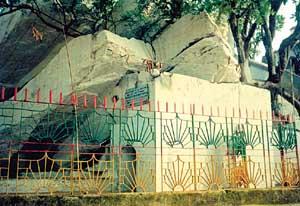 Vyasa
deva? The
author of the ‘Mahabharata’?
I ask nobody in particular. The young priest who also doubles as
a guide nods, quoting a ‘sloka’ in broken Sanskrit which he
later translates — ‘‘To the west of the river Brahmi, in
the midst of a deep jungle was the ‘ashram’ of Vyasa. Every
morning the saint took bath in the waters of the Saraswati and
offering paeans to Lord Vishnu, sat in meditation”. Vyasa
deva? The
author of the ‘Mahabharata’?
I ask nobody in particular. The young priest who also doubles as
a guide nods, quoting a ‘sloka’ in broken Sanskrit which he
later translates — ‘‘To the west of the river Brahmi, in
the midst of a deep jungle was the ‘ashram’ of Vyasa. Every
morning the saint took bath in the waters of the Saraswati and
offering paeans to Lord Vishnu, sat in meditation”.
The crowds listen as they peep reverentially into the cave.
“Brahmi” is taken to refer to the Brahmani River in western
Orissa. And therefore the inference that this ruined cave,
situated west of that river, must have once been sage Vyasa’s
‘ashram’.
So did the sage Vyasa really live here? The pilgrims firmly
believe so and it is a ‘tirthasthal’ also because it is at
the confluence of three rivers — the Koel, the Sankh and the
Saraswati.
I look for the young priest. He is regaling the crowd
with the popular legend that the great
saint Parashara, Vyasa’s father, lived near this place in a
village that was known as ‘Parasharmunda’. Whenever he
wanted to cross the river a boatman used to ferry him across.
Once when the boatman was not there, his daughter
‘Matsyagandha’ offered to ferry Parashara across the river.
Parashara fell in love with the girl and Vyasadeva was the
result of that union. The name “Vedavyasa” originates from
the fact that it was Vyasa, a great Vedic scholar, who divided
Vedas into different parts.
The devotees come to Vyasadeva all year long, bathing in the
river with prayers for help and blessings in their hearts. I
shut my eyes and imagine the cool, dark inside of a cave that,
so many hundreds of years ago, saw the birth
of one of the greatest books ever written...
(source: Here
lived Vyasa - newindpress.com).
For
more refer to chapter on Greater
India: Suvarnabhumi and
Sacred
Angkor
Top
of Page
|